June 24 - 30, 2018: Issue 365
Historic Photographers Of Pittwater: A. J. (Arthur James) Vogan, 1859-1948
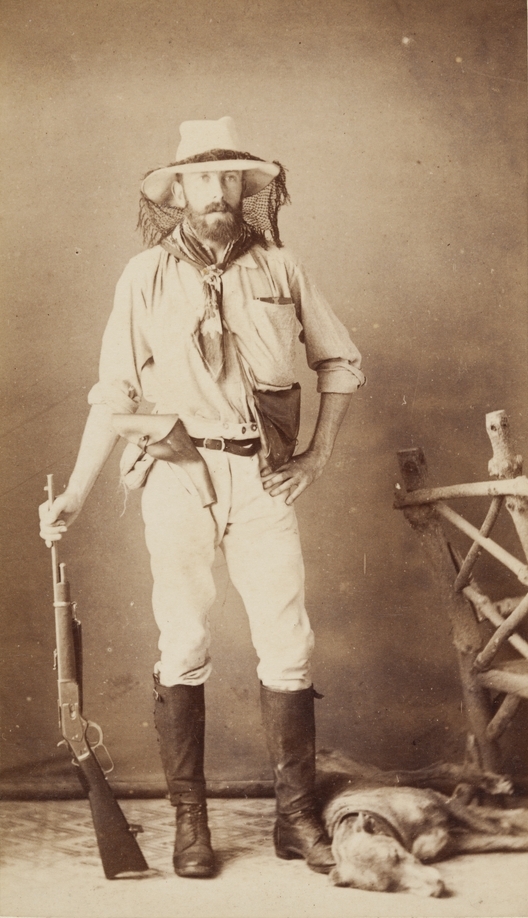
It’s no secret that Pittwater Online News is in the business of celebrating and promoting local photographers. Since early Issues we have sought out and asked permission to share the brilliant images captured by everyone here, whether they have the best equipment and can get wondrous captures or those who simply are at the right place in the right moment and know how to use their phone's camera. We have also had the creme de la creme of professionals whether in landscape, portrait, art, social or action share the images they get enmasse that many of us would be happy to capture just one of just once.
These are Visions that not only record what's happening and when it is, they are what those who are ill and can't get outdoors, or those who may be less mobile continually thank us for sharing. When really it is we who say; Thank you all!
In 2018 we extend our love of photography and photographers to sharing a series on those who came before those who add to the current records. Regular Readers may have suspected this was coming.... Pittwater Online delay too long at running a series that combines History with Photography - not likely!
These are also works that people collect due to their intrinsic and ongoing growing value dollar-wise as much as for showing a favourite local place as it once was or a 'Vision' as created to communicate something internal present in the external when made by a Creative. Whether the original plate-glass or negative or a copy, most of us have at least one or two at home, or a whole book of them.
One such Visionary has works that have appeared in various History pages gaining all an insight into how Pittwater looked in the days before many of us now here were born. He held land at Newport and was an early owner of a 'motor-yacht'.
Arthur James Vogan is more well known as a Sketcher, Journalist, lover of horses, Explorer and for an interest in Archaeology and Anthropology that stretched throughout his life (although many of his theories were a little fanciful according to those who assessed them then and afterwards). [2.]
Many would also point to his written works and the book ‘Black Police’ as he was also a champion of the original custodians of Australia, as what he is known for, particularly plaguing the council north of here to look after and protect Aboriginal carvings he found at Woy Woy. He was also active in trying to conserve other areas of Australia in an era and time when such notions ran against the appetite to have more and put what was already here last.
The full title of that 1890 published work; 'The black police: a story of modern Australia' by A.J. Vogan; with illustrations and map by the author, also brought up some accusations against its author of seeking attention through sensationalism but at least this work added to and commenced another aspect of a debate that was way overdue.
First, a little about the gentleman himself from those who were around to hear it straight from him and threads garnered through Research.
Arthur James Vogan was born on 8 August 1859 at Dartford in Kent, England to James and Mary Elizabeth. They married at Lewisham in 1853 and lost children prior to moving to New Zealand:
Raymond Reginald infant son of James and Mary Elizabeth VOGAN of Greenhithe died 26 September 1858 aged 8 months. Harry James likewise son of above died 6 February 1859 aged 4 years 4 months. Also their sister, Mary died 15 August 1862 aged 5 weeks. Frederick Overall Vogan son of above died 9 May 1865 in his 10th year. Some Monumental Inscriptions of Swanscombe Church, Kent Archaeological Society.
He emigrated with his family to New Zealand in 1879 to take up farming and horse-breeding at Te Puke in the Bay of Plenty region of New Zealand. He trained as a surveyor and also worked as a journalist and illustrator with the Auckland Star and the Bay of Plenty Times.
In 1885, at the age of twenty-six, he volunteered to join an expedition to New Guinea funded by the Geographical Society of Australasia. His voyage north from Sydney on board the Bonito in July 1885, with stops in Brisbane, Rockhampton, Bowen, Townsville, and Cooktown, may have been his first venture into Queensland. According to one article he soon tired of the rigours of a farmer's life and after having a few works published in New Zealand papers moved to Sydney in 1885 to follow the life made from wielding a pen. He served in the Boer War, travelled extensively throughout Australia and the Pacific
LOCAL AND GENERAL
Mine-owners and others in the outlying and comparatively little known districts will be glad to learn that we have arranged with Mr. Arthur James Vogan, late artist mining reporter for the Town and Country Journal and Australian Mining Standard, to make series of special reports upon the various mining centres. These articles will appear, suitably illustrated, in the PIONEER and MINER. Mr. Vogan is best known perhaps through the accounts of his travels in New Guinea, Queensland, New Zealand and elsewhere, which have appeared in various publications, notably the Illustrated London News, which paper he represented in Australasia as British correspondent in '87, and '89. Mr. Vogan has many acquaintances amongst the Northern prospectors; and he is he proud possessor of a handsome prismatic compass and medallion, presented to him by the miners of Niagara, on his having in that place where he was mining, in recognition of his skilful and gratuitous services in cases of sickness and accident. LOCAL AND GENERAL (1896, July 8).Coolgardie Miner (WA : 1894 - 1911), p. 4. Retrieved from http://nla.gov.au/nla.news-article216673460
Mr. A. J. Vogan.
We publish this week the portrait of Mr. Arthur James Vogan, F.E.G.S., author of the ' Black Police ' and other works, who is at present in Sydney on business in connection with a light tramway for the Hot Lake districts of New Zealand. Besides being one of the best known special journalists in Australia (having acted as Artist-Correspondent here for the "Illustrated London News' for some years, as well as doing similar work for numerous colonial papers), Mr. Vogan has made a name for himself as an explorer in New Guinea and Central Australia.
Amongst the most interesting of his discoveries on this continent was that of the little group of thermal spring terraces — the only example of such at present known in Australia, and similar, rave maize, to those of New Zealand — near the Etnsleigh River in North Queensland, which formed the basis of i paper read by Mr. Vogan before the Royal Geographical Society of Australasia in Sydney in 1887. This gentleman's latest geographical work has been the large coloured map of the Coolgardie goldfields (where Mr. Vogan spent over two years), published last year by Messrs. G. Robertson and Co.
Mr. Vogan commenced his press-life in 1885 in the columns of this paper, numerous sketches and descriptive letterpress illustrative of explorations he was engaged in in New Guinea on behalf of the R.G.S. of Australasia being published by the 'Sydney Mail.' The following year the subject of this sketch was fortunate enough (from a pressman's point of view) in being present in New Zealand during the great volcanic eruption of Mount Tarawera. He was probably the first person to reach the affected district from Auckland, and formed one of the rescue party who saved numerous lives by unearthing those unfortunates whom the heavy falls of mud and volcanic ejecta had buried in their whares. His sketches made at this time were the first to reach London, and led to his engagement by our great London contemporary, already referred to, and to his services being utilised for the illustrating of a book published by the 'Auckland Star.'
Since then Mr. Vogan has thrice traversed this continent, besides having professionally visited most of the principal mining centres. A man of many parts, Mr. Vogan holds the coveted reward of the Royal Humane Society for saving life from drowning; was the first captain of the Auckland (N.Z.) City Rowing Club ; and since 1878 (when he resided in London) has been an enthusiastic member of the St. John Ambulance Association.
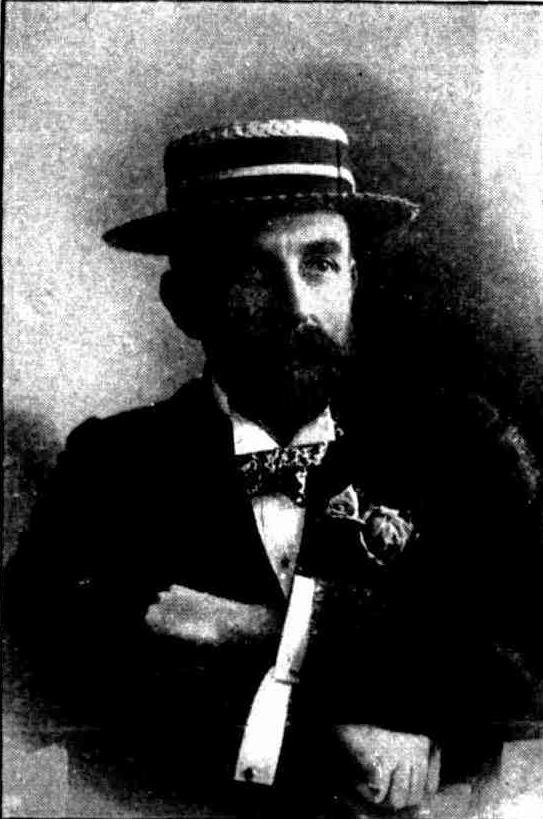
MR. A. J. VOGAN.
Mr. A. J. Vogan. (1897, August 28). The Sydney Mail and New South Wales Advertiser (NSW : 1871 - 1912), p. 445. Retrieved fromhttp://nla.gov.au/nla.news-article163795029
This one has a few inaccuracies, his age for instance, but records an overview:
Who Caught Saheepers ?
SERGEANT A. J. VOGAN'S CAREER. WHAT HE DID IN AUSTRALIA.
Sergeant Arthur Vogan, who is believed to be identical with the Australian scout who captured Scheepers, regarded as the most important of the Boer raiders yet fallen into the hands of the British in South Africa, is a man who has played many parts in Australia (says the Sydney "Daily Telegraph"). "Letters recently to hand from him to his brother, Mr. H. S. Vogan, of the drawing office of the Railway Department, are dated from centres in the southern part of Cape 'Colony, and tell of the very great hardships the men are undergoing. It was rather galling, he explained, that those who were bearing the brunt of the battle should be compelled to sleep out in the open 't nights, to wake up in the mornning and find their beards matted with frost, while the officers were carefully sheltered in the Boer farm-houses. The same marked line of distinction was made in the matter of food, he explained, so that he contended he was justified in admitting that he was tired of hie five months' fighting. To show in a practical way the effects of the hard life he and his comrades of the Prince of Wales's Light Horse had been leading, he said that out of some 200 strong they had dwindled away to 865. This statement strengthens the opinion that the remnant of this body of men was eventually attached to the regulars as scouts, and explains why Vogan was with a troop of Lancers when he captured the wily commandant.
Sergeant Vogan, who is 40 years old, is a native of London, and arrived with his family in Tauranga, New Zealand, 20 years ago, where he settled down as a farmer, and a which district his father still resides. For four or five years he battled with the difficulties of an agricultural life, but his adventurous spirit made him restless, and he decided to visit New South Wales.
On his arrival here in the year 1886 he was induced to join the Exploration party, headed by Captain Everill, formed for the purpose of throwing light on some of the dark spots of New Guinea. His special post was that of "artist and explorer," and his early studies as a surveyor stood him in good stead on that occasion. It was reported during their absence that the whole party were massacred by the natives, but they eventually all got back to Sydney after experiencing some hardships.
On his return to Sydney, Vogan took up journalism as a profession, and after a tour through Queensland in that capacity he published a book entitled "Black Police," in which he sought to expose the treatment the aborigines of North Queensland were subjected to by the white population. On a couple of occasions he undertook successfully to travel across the continent, while he also effected some venturesome expeditions as a cattle-drover through Queensland, to Alice Springs, and other parts.
Returning to Sydney, he joined the Railway Department, and for some time controlled the commissioners' advertising arrangements. Then the West Australian boom came and he was despatched to that State by a railway syndicate to see what could be discovered there in the way of gold reefs. He came across but few rich finds, however, and after remaining ever there for some time, once more found his way to New South Wales.
The war fever was then running at its height. Citizens were organising their contingent for the front, and Vogan was picked as a suitable sergeant. While the men were being trained and selected, he saw so much with which he did not agree that he spoke freely and unhesitatingly denounced the methods employed by those in charge. For this interference he was degraded to the rank of an ordinary trooper, so be packed his baggage and quitted the camp. Then he travelled across to New Zealand, where he enlisted for service in South Africa, and on arrival there was attached to the Prince of Wales's Light Horse. While in West Australia he obtained a gold medal from the St. John Ambulance Society, and on his departure from Niagara the residents presented him with a testimonial and several souvenirs for the help he had rendered them in the matter of first aid in accident and other cases of illness.
Who Caught Scheepers? (1901, October 24). Queensland Times, Ipswich Herald and General Advertiser (Qld. : 1861 - 1908), p. 9. Retrieved from http://nla.gov.au/nla.news-article122950285
Mr. Vogan named both a house he owned at Hornsby and the motor-yacht he owned for a time ‘Gwalia’, after one of the most successful mines on the Coolgardie goldfields in Western Australia.
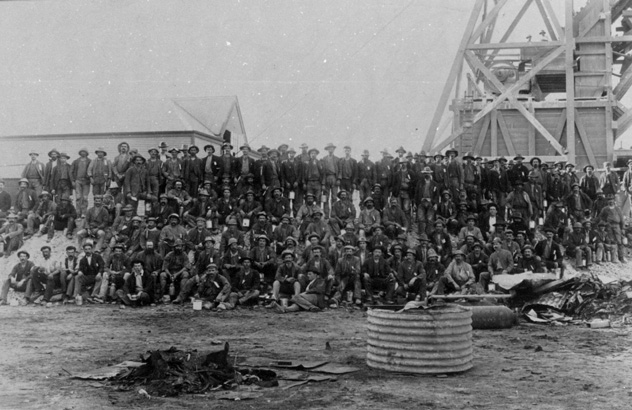
Peter Fullwood's shift at Sons of Gwalia gold mine,1901. (Battye 003981d) - courtesy state Library of WA
A YACHTSMAN'S GREETING.
The only Sydney yacht to meet the Australian fleet outside the Heads on Saturday was Mr. A. J. Vogan's Gwalia. Starting early, so as to avoid being detained in part by the Harbour Trust's regulations, Mr. Vogan took his party and met the fleet seven or eight miles outside the Heads, being the only yachtsman present with his craft to welcome the new-comers. The Australia returned the Gwalia's salute, although it is not customary for men-o-war to notice any salutation.
A YACHTSMAN'S GREETING. (1913, October 6). The Sydney Morning Herald (NSW : 1842 - 1954), p. 8. Retrieved fromhttp://nla.gov.au/nla.news-article15455470
At the request of Dame Margaret Davidson, Mademoiselle Soubieran, of the French-Australian League of Help, and well known in connection with her Red Cross activities during the war, is making inquiry into the rather vexed question of the French wives of returned soldiers, certain of whom are apparently not too happily placed. A preliminary meeting of ladies Interested, was held on Thursday at Gwalia, the-residence of Mr. A. J. Vogan, at Hornsby, there being present Mademoiselle Soubieran, Meadamos Doucet, Barr, Jr., Ar-ranger, Mrs. Ton» Brown, and Miss Rita Baker. WOMEN'S COLUMN. (1921, April 18). The Sydney Morning Herald(NSW : 1842 - 1954), p. 6. Retrieved from http://nla.gov.au/nla.news-article15955200
He also owned land at Pittwater which was called 'Vogan's Point" in a 1913 land sale (see below) that was opposite the Newport Hotel and 'Vogan's Point'. A letter about the destruction of birds in January 1914 shows he is at 'Newport' then, so if some properties were sold, some was also held onto. His aim in selling his holdings was to further his work and the costs this incurred, for travelling, became more expensive as time went on. The ownership of this vessel may account for some of the from the water views that are among his photographs:
NOTICE UNDER REAL PROPERTY ACT.
APPLICATIONS having been made to bring the lands hereunder described under the provisions of the Real
Property Act, Certificates of Indefeasible Title will issue, unless Caveats be lodged in accordance with the Third Schedule to the said Act, on on before the 6th of December, 1911 : —
No. 17,276. APPLICANT:—Arthur James Vogan, Neutral Bay. LAND :—County Cumberland, parish Narrabeen, sliire Warringah, 4 acres 2 roods 4 perches, in Crescent-road and The Avenue, at Pitt Water,—lots 31b, 31c, 32, and 33 section 5, Mona Vale Estate, and part 700 acres (portion 17 of parish), granted to Robert Campbell ; adjoining property of The Australian Bank of Commerce (Limited).
NOTICE UNDER REAL PROPERTY ACT. (1911, November 1). Government Gazette of the State of New South Wales (Sydney, NSW : 1901 - 2001), p. 5769. Retrieved from http://nla.gov.au/nla.news-article226916929
FREIGHTS TO QUEENSLAND.
TO THE EDITOR.
Sir-Last year I obtained from various shipping companies then prices for shipping my motor-yacht from Sydney to certain Queensland ports. The deep-sea companies quoted their prices, as did the intercolonial companies. I was prevented by domestic affliction from finishing certain explorations I began years ago, last year, and this year I have again, being free, approached the companies. The NavigationDepartment or some authority now prevents the deep-sea water competition with the intercolonial and we have, naturally, an enormous rise in freights. One intercolonial company that last year asked £25 pounds to carry my boat, asks this year £85, and another that wanted £35 last year requires me to pay £75 this year. The return-first passenger rates have also increased from £11 to over £16.
I am offering these facts to your readers sir because it seems to me that it must be bad for ill classes in Queensland that such a sudden and enormous to be placed upon passengers and goods from the Southern States. It is also a very good object lesson of the need of competition when the best interests of the public are concerned.
Years ago I made certain important discoveries of a mineral nature in North Queensland littoral. I want now to further investigate the same I find that every obstacle is placed in my way by the intercolonial companies-who would be the first to profit by the success of my work. I have done much in exploring and opening up New Guinea and Australian goldfields but what with bad mining laws (the worst absolutely in the world) the labour problem added to by those paid union officials who batten on strikes and other increased expenses no wonder the last returns show that no prospecting is going on and that the mineral returns are less every year. And on top of it here comes the unwarranted rise in freights of the steamship companies of 150 per cent m one year-I am sir, &c ,
A. J. VOGAN.
Sydney. June 24.
FREIGHTS TO QUEENSLAND. (1914, July 6). The Brisbane Courier (Qld. : 1864 - 1933), p. 8. Retrieved from http://nla.gov.au/nla.news-article19969462
His father James passed away on January 8th 1911 in New Zealand.
His mother Mary Elizabeth passed away on July 22nd, 1913 at North Sydney, aged 87 - his sister in NZ stated she was 88 in her family notice. Her parents, named Samuel and Mary, were commemorated in the names of her own children.
VOGAN - July 22nd, 1913 at 30 Lord Street, North Sydney, Mrs. M. E. Vogan, widow of the late James Vogan of Lewisham, England and Tauranga, N.Z., aged 87 years. Family Notices (1913, July 25). Newcastle Morning Herald and Miners' Advocate (NSW : 1876 - 1954), p. 4. Retrieved from http://nla.gov.au/nla.news-article137619290
He had retired from journalism and become by then a prolific letter writer whose opinions on everything appeared in most of the newspapers of the time on a weekly basis (see samples of below).
RECRUITS FOR LONDON.
LIEUTENANT VOGAN'S OFFER.
Lieutenant Arthur J. Vogan, of the Legion of Frontiersmen, has received a cable from London, through his cousin, Mr. Randal Vogan tor Vogan and Company, Mark Lane, London), in reply to his letters and cables offering tic authorities In England 500 officers and men, mostly with active service experience. The reply states: 'Your men of the age of 19 to 38, if passed fit for service by the medical authorities of the Commonwealth forces, will be accepted here for Edward'd Horse or Cavalry on arrival.” This communication has been forwarded to Colonel Wallack for the necessary certificates to be issued. RECRUITS FOR LONDON. (1915, January 4). Evening News (Sydney, NSW : 1869 - 1931), p. 4. Retrieved from http://nla.gov.au/nla.news-article114244481
CENTENARY OF BOTANIC GARDENS.
Sir, — May I venture to inform the Sydney folk that the centenary of the Botanic Gardens will occur on June 13 next. So far no preparation has been made for that occasion, and I think very few persons have knowledge of the fact. May I suggest that one item of any arrangements made tor a fitting commemoration might take the form of inviting Mr. Maiden, the well-known curator, to plant a 'Maiden's tree' in the newly-acquired portion of the grounds. The bestowal upon our Government Botanist of the Fellowship of the Royal Society, London, comes very fittingly abreast of the centenary of the gardens that he has done so much to improve. I will be very pleased to hear from anyone desirous of initiating arrangements for such commemoration, and should sufficient encouragement offer will call a public meeting to elect a committee, etc. — I am, sir, etc.,
ARTHUR J. VOGAN.
'Broombee,' Milson's Point. "
SUNDAY TIMES" POST OFFICE (1916, March 12). Sunday Times (Sydney, NSW : 1895 - 1930), p. 14. Retrieved from http://nla.gov.au/nla.news-article121336178
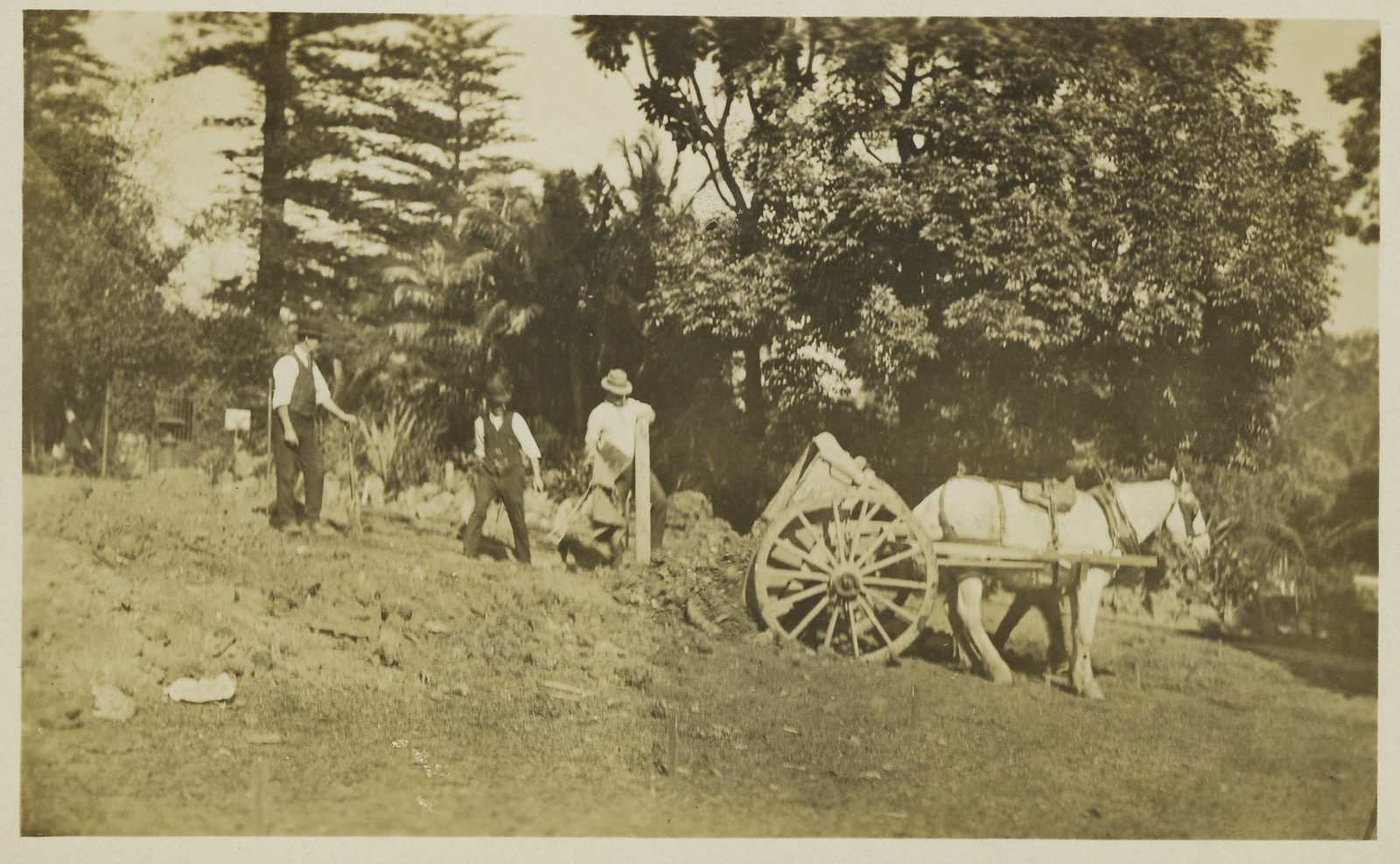
Botanical Gardens, Sydney [picture]. Photo by A. J Vogan. Courtesy State Library of Victoria. Image H82.254/8/51

McMahon's Point, Lavender Bay, Sydney, looking south. Author / Creator; Vogan, A. J. (Arthur James), 1859-1948, photographer. Date [ca. 1910 - ca. 1915] Courtesy State Library of Victoria.
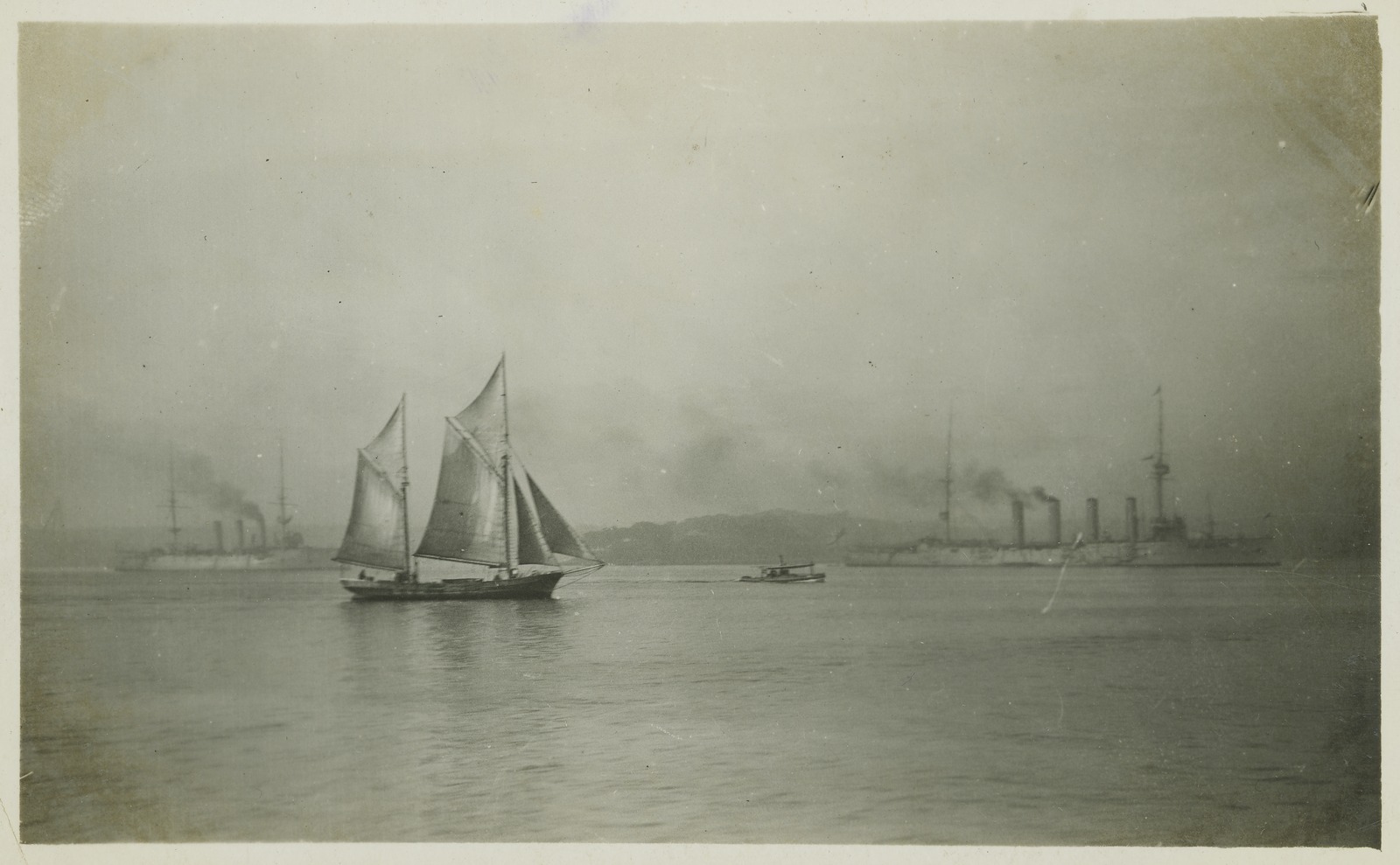
A foggy morning on Sydney Harbour [picture]. Photo by A. J Vogan. Courtesy State Library of Victoria. Image H82.254/8/46

Farm Cove, Sydney [picture]. Photo by A. J Vogan. Courtesy State Library of Victoria. Image H82.254/8/30
Mr. Vogan's first evidence of taking a photograph in our area relates to the unfortunate demise of another who clearly had a few dreams and schemes associated with the peninsula:
Died in the Bush.
THE NARRABEEN MYSTERY. THE CORONER'S INQUEST. AN OPEN VERDICT.
At the Croydon Hotel, .to-day, before Mr. J. C. Woore, City Coroner, an inquest was opened regarding the death of the man whose body was found in the bush at Narrabeen, on the 1st instant. Senior-sergeant M'Intosh watched the case on behalf of the police.
Alfred M'lntosh deposed that he. was a boarding-house keeper at Narrabeen. On Monday morning at 7.30 he was in the bush at Long Reef with Ernest Yates and others. He found the remains of the body lying on its back.' The left arm was extended, and the right lay across the body. The boots were off, and a blanket covered the upper part of the body. There was some clothing under the shoulders and head, and other clothing was lying near. There was a billy near the feet, but no traces of a fire. Witness was present when the photograph produced was taken. It represented the position of the. body. He could positively identify the clothing deceased wore as that of a man he spoke to about two months ago in the same locality. He did not know his name, and could not remember the exact date when he spoke to him. Witness was talking to 'him regarding mining at Long Reef. Deceased did not say anything regarding his name or where he lived. He told, witness he intended returning to Sydney in a day or two. Deceased had a billy, pannikin, tomahawk, and knife, and was within threequarters of a mile from where the body 'was found. A young man about 26 years of age was with deceased. Witness did -not know him, and had not seen him since. They were cooking at the time. The body was about 20 yards from high water mark.
About 60 or 70 head of cattle ran about there. After finding the remains they were photographed by a Mr. Vogan, and the police were sent for. Senior-Sergeant M'Intosh, took the remains in charge. Identified the book produced, having written in it at the request of deceased with a pencil handed him by the young man. He believed the knife produced to be one he saw with deceased. Deceased's companion was like a sea-faring man. He wore a complete suit of blue serge and a can, had no hair on his face, and was dark with close-cut hair. He was about 5ft 9in in height. Deceased showed witness some samples of clay. Similar clay was found in a bag near the remains. Deceased was a short, thick-set man of slovenly appearance, and had a strong foreign accent. He spoke to witness of j having been in Germany, where he was engaged in making cement. In appearance the man was like a German. The young man said he had been with deceased about a fortnight, and had been in the colony about seven months. He was an Englishman and spoke very accurately. Deceased said he had money, and showed -witness a bag saying he had enough there to get a miner's right and a pair of boots so as to go to work on the reef. Henry Cohen, dealer, living near Manly, said he identified the clothing at the Morgue as that worn' by a man he saw near his camp some time in November. Witness saw him twice, and there was no one with him at first. He described the appearance of deceased and his clothes, and said he appeared to be about 50 years of age. Witness thought from his speech deceased was a Scotsman, and he spoke of Aberdeen. He showed witness some clay he got from Dee Why Lagoon, at Narrabeen, and said he was an old New Zealand miner. When witness saw deceased the second time a young man was with him. Deceased said he had been to the Lands Office three years ago regarding the working of the land at Dee Why. He also said he was going to get up a syndicate to work the clay, and that he had a gentleman behind him. The young man wore dark clothes and a black hard hat ; he was about 30 years of age, clean shaved, and of dark complexion. Constable Clibbon, stationed at Manly, deposed to finding the memo book produced and also a circular from the Fisheries Department among the clothes of deceased. The latter was addressed to ' A. Hunter, Wellington, N.S.W.' A portion of a packet of sugar of lead, labelled, was in the inside breast pocket of the coat. A small bottle and Id were found in the trousers …
George E. Rennie, Government Pathologist, deposed that he had examined the remains of deceased. He had been a man of between 50 and 60 years, and had been dead about two months. There was scarcely anything but the skeleton left. The skull and breast bone were broken. In his opinion, this was done after death. Portion of the scalp adhered to the skull, and there was no trace : of blood on it. Nothing whatever was found \ to indicate the cause of death. The breakage of j the bones might have been caused by the tramp- ', ling of cattle.- If the bones of the head had been ; broken during life, witness would have expected to have found blood on them.
Arthur James Vogan, of the Railway Estate Branch, gave evidence as to having been with the witness Mintosh when the body was found. Witness photographed the remains exactly as they found them. Deceased had evidently died in agony as his fingers were dug into the ground, and his feet and legs were contorted. James Day, mariner, residing at Manly, deposed that he last saw the man he believed to be deceased about two months ago. That was when corning back from Manly in the steamer Fairlight. He was one of the passengers. Witness was one of the crew of the steamer, and often saw him before on board, and spoke to him. Did not know him by any other name than ' Scotty.' He told witness five or six times that he was after clay near Long Reef, which he said was good for paint or fireclay. The clothing on the remains resembled those worn by ' Scotty,' and so, too, did the hat he saw. The last time witness saw the man he remarked to 'him (witness) that he had not been very well.
Senior-sergeant M'Intosh, of Manly, produced a memo book found in a bag near the remains. In the book was an entry in red ink. It was compared with letters sent by Archibald Hunter to the Fisheries Department, the address being 'Wellington Post Office.' The letters were regarding some persons fishing in the Macquarie. They corresponded with the entries in the book, were in the same handwriting, and had, apparently, been written on leaves torn from the book. One bore date October 13, and the other October 14, 1893. Livingstone F. Mann, draftsman in the Fisheries Department, produced two letters written in red ink on paper like that in the memo, book, and signed 'Archibald Hunter, Wellington.' The jury returned a verdict to the effect that the deceased, whose name they believed to be Archibald Hunter, came to his death on or about November 20, 1893, and that there was no evidence to show the cause of death.
Died in the Bush. (1894, January 3).Evening News (Sydney, NSW : 1869 - 1931), p. 5. Retrieved from http://nla.gov.au/nla.news-article114070421
Mr. Vogan put his money where his mouth was throughout his career and although he received money for doing work for mining companies and a stipend from the Vogan business in London as well as a small literary pension, but it was not enough.
COMMONWEALTH LITERARY FUND.
HIS Excellency the Administrator in Council has approved of the payment of a pension from the Commonwealth Literary Fund at the rate of One pound per week to Mr. Arthur James Vogan as from the 15th June, 1938.
V. C. THOMPSON, for Minister for the Interior.
COMMONWEALTH LITERARY FUND. (1938, June 30). Commonwealth of Australia Gazette (National : 1901 - 1973), p. 1828. Retrieved from http://nla.gov.au/nla.news-article232689280
After he sold the home at Hornsby he lived in small flats in Mosman and surrounds. By WWII he was living in the Salvation Army's Pacific Lodge Home in Dee Why.
While he was at the old folks home he often walked to Long Reef. One day in 1948 he noted a shell midden and, at the age of 87, speculated that this midden was likely to have been formed by the Asians or 'Persians' who came down the eastern Australian coast, teaching the Aboriginal people their Moon Cult and leaving instructional engravings. What he told his friend however, was that he thought its main benefit would be in being dug up to provide shell-grit for people who kept chooks [Vogan Papers Box 8: AJV to Parham 2.2.1948].
Arthur Vogan died on 27 February 1948, after a fall from which he did not recover. [2.]
His visits to Pittwater and when he wrote of these give some indication of the age of the photographs shared below - these few are perhaps part of many more that may come to light one day:
SCOTLAND ISLAND.
Mr. A J. Vogan writes:— "What Vesuvius is to Naples, Mount Eden to Auckland, or "Our Beautiful Harbor" to Sydney, so is Scotland Island to Plttwater. And this lovely 'Isle of Eden' is now to be handed over to the 'week-ender, who has desecrated what was once our peaceful and beautiful Middle Harbor, and rendered many of our other one-time holiday picnic spots wildernesses of uncouth huts where half-savage creatures give full play to their atavistic cravings, to the annoyance of civilised folk and to the destruction of the scenery.
"When In March, 1788, Captain-Governor Phillip, the first explorer of Broken Bay, wrote 'Immediately round the headland that forms the southern entrance to the port there is a third branch, which I think the finest piece of water I ever saw,' he was only voicing what was to be the general opinion of most of those who were to follow in his footsteps. It has been my privilege and business to visit many of the most beautiful places in the world, and I know every portion of Australia, and, with, perhaps the exception of Hinchinbrook channel and its neighbor, Mourillyan Harbor, Pitt-water remains peerless to-day amongst Australian scenic gems.
Yet we Sydney folk who have this at our doors are going to allow that vandal, the bachelor 'week-ender' to desecrate this pearl amongst places.
"This Island was reported on as the most suitable spot for the naval college; but land-agent wile and political pull erased the verdict of the experts. Better this far than to surrender this island to the fate of Middle Harbor with its huts, its dancing bells, its insanitary 'sanitary' depots pouring typhoid germs into its waters and its 'week-end' drunken bowlings and indecencies."
"It is characteristic of your paper that the public was first made aware of this projected sacrilege through Its columns."
SCOTLAND ISLAND. (1911, September 29). The Sun (Sydney, NSW : 1910 - 1954), p. 15 (LATEST EDITION). Retrieved fromhttp://nla.gov.au/nla.news-article221546281
Although Mr. Vogan clearly made some income from his photographs, what camera or equipment he used remains a mystery.His images of what is possibly a vast collection is now, are everywhere - in the Australian Museum, in the National Library of Australia, in the State Library of NSW, of whom he was a great supporter and left all his own records to.
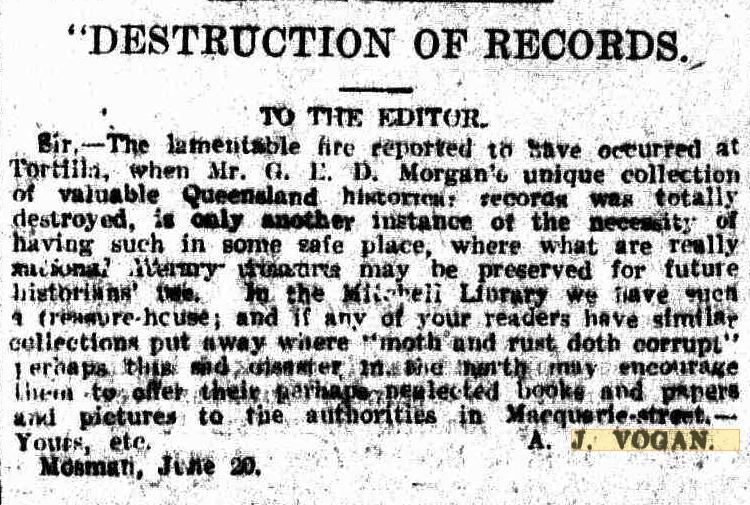
"DESTRUCTION OF RECORDS. (1913, June 21). The Daily Telegraph (Sydney, NSW : 1883 - 1930), p. 11. Retrieved fromhttp://nla.gov.au/nla.news-article240049932
We now have these wonderful insights into an earlier Pittwater he clearly had an affinity for thanks to the great work our State Libraries do and of you cannot purchase one of his prints for your own walls anymore you can still get copies of them from and courtesy of these libraries who have extended the archival records they hold beyond the realms of books on shelves - although curling up with a great work is always a great thing to do!:
Arthur James Vogan - Pittwater (And Environs) Photographs
Photographs all from State Library of Victoria - Housed in a postcard album. Written on the inside of the front cover: June 1914. Photo's taken in New South Wales & Queensland by A. J. Vogan Esq. Special Correspondent of the Illustrated London News at the time of the Eruption in New Zealand. His book 'Black Police' deals with the brutality dealt out to the Natives of Queensland by the early settlers.
E. E. Wagstaff collection. Ernest Edward Wagstaff (1870-1965) was born in Essex, England and came to Melbourne in 1904 to become the first General Manager of British Imperial Oil Co. Ltd. He held this position until 1927, when the company changed it's name to Shell Co. of Australia Ltd. He was a motoring enthusiast, and made trips such as a Melbourne to Sydney trip in 1901, and Melbourne to Adelaide in 1908. Source / Donor: Gift of Mr J. C. Trinca, 1982.

at Refuge Cove, ... Bay [picture]. circa 1910-1915. Photo by A. J Vogan. Courtesy State Library of Victoria. Image H82.254/8/22 - Title written on verso.
MARITIME SERVICES ACT, 1935.—NOTIFICATION
Limitation of Speed of Vessels Within Certain Navigable Waters
THE Maritime Services Board of New South Wales, in pursuance of the provisions of section 13sa of the Maritime Services Act, 1935, hereby as on and from the date of publication of this notification in the Gazette—
(a) revokes the notification appearing in Government Gazette No. 121 of 4th October, 1974, which limits the speed of certain vessels in the area described as Pittwater (Bayview) Area;
(b) revokes the notification appearing in Government Gazette No. 70 of 16th May, 1975, which limits the speed of certain vessels in the area described as Pittwater (Careel Bay) Area; and
(c) limits the speed of vessels of the class set out here under in the area of navigable waters described in the first column of the Table of Area and Maximum Speed set out hereunder to a speed not exceeding that stated opposite that area in the second column of that Table of Area and Maximum Speed.
Class—All vessels propelled by mechanical power except vessels engaged in an organized regatta or aquatic carnival authorized by the Board.
Table of Area and Maximum Speed
First Column
Pittwater (General) Area.—The navigable waters of and/or adjoining Careel Bay, Paradise Beach, Clareville Beach, Long Beach, Refuge Cove, Salt Pan Cove, Horse Shoe Cove, Crystal Bay, Newport, Bayview, Church Point, McCarrs Creek and Elvina Bay, enclosed by the following direct lines; commencing at the northwestern corner of Dark Gully Reserve, Careel Bay, thence to the northern extremity of Stripe Point (Stokes Point), thence to the extremity of Taylors Point, thence to No. 2 navigational beacon (Salt Pan Beacon) situated off Newport, thence to No. 7 navigational beacon situated off Bayview Public Wharf, thence to No. 8 navigational beacon situated off Church Point, thence to the eastern extremity of the unnamed point on the southern side of the entrance to Elvina Bay, and finally to the southeastern extremity of Rocky Point. Second Column Eight knots.
MARITIME SERVICES ACT, 1935.—NOTIFICATION (1976, January 23). Government Gazette of the State of New South Wales (Sydney, NSW : 1901 - 2001), p. 330. Retrieved from http://nla.gov.au/nla.news-article220113866
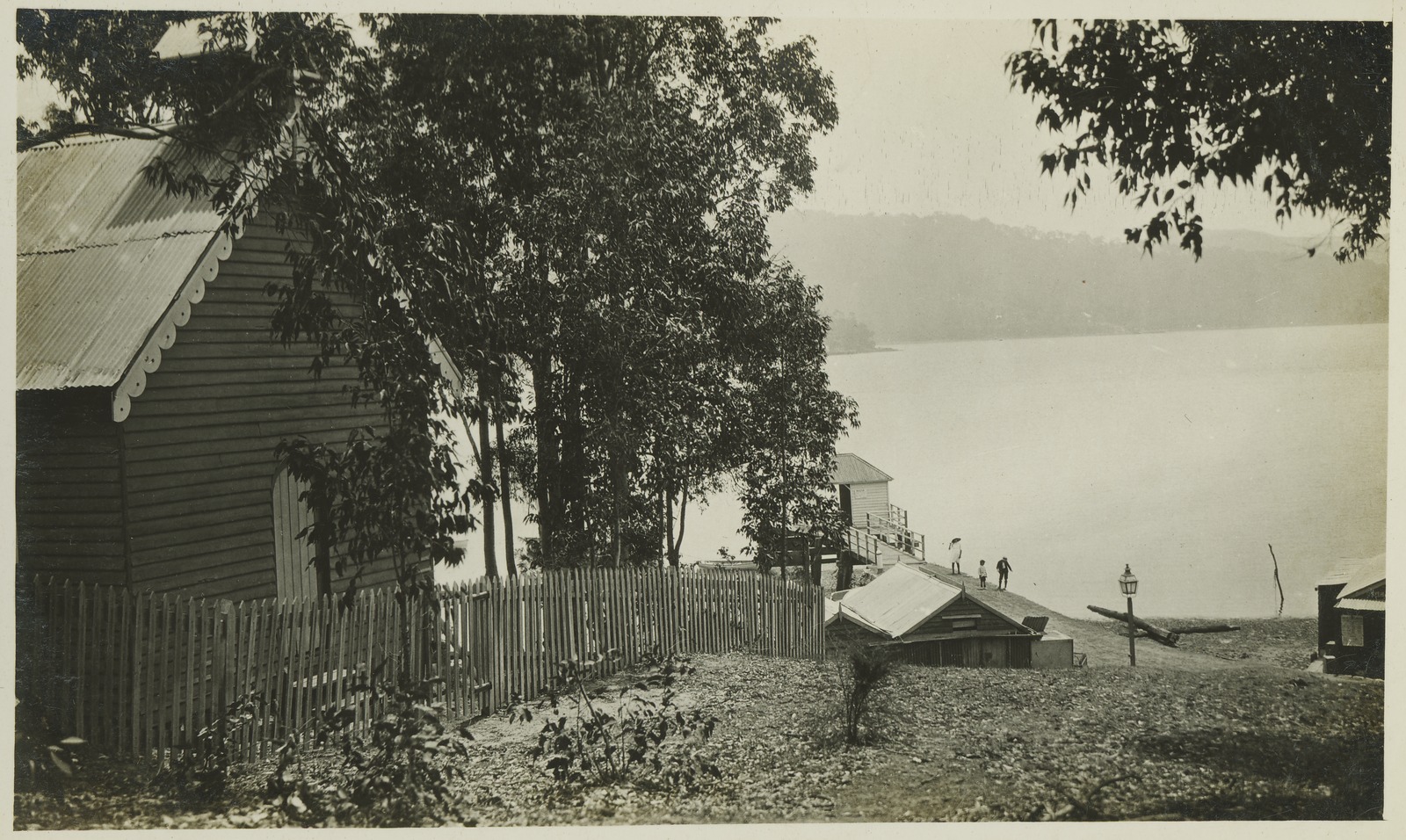
Church Point, Pitt Water, 20 mins n. from Syd. [picture]. Photo by A. J Vogan. Courtesy State Library of Victoria. Image H82.254/8/29
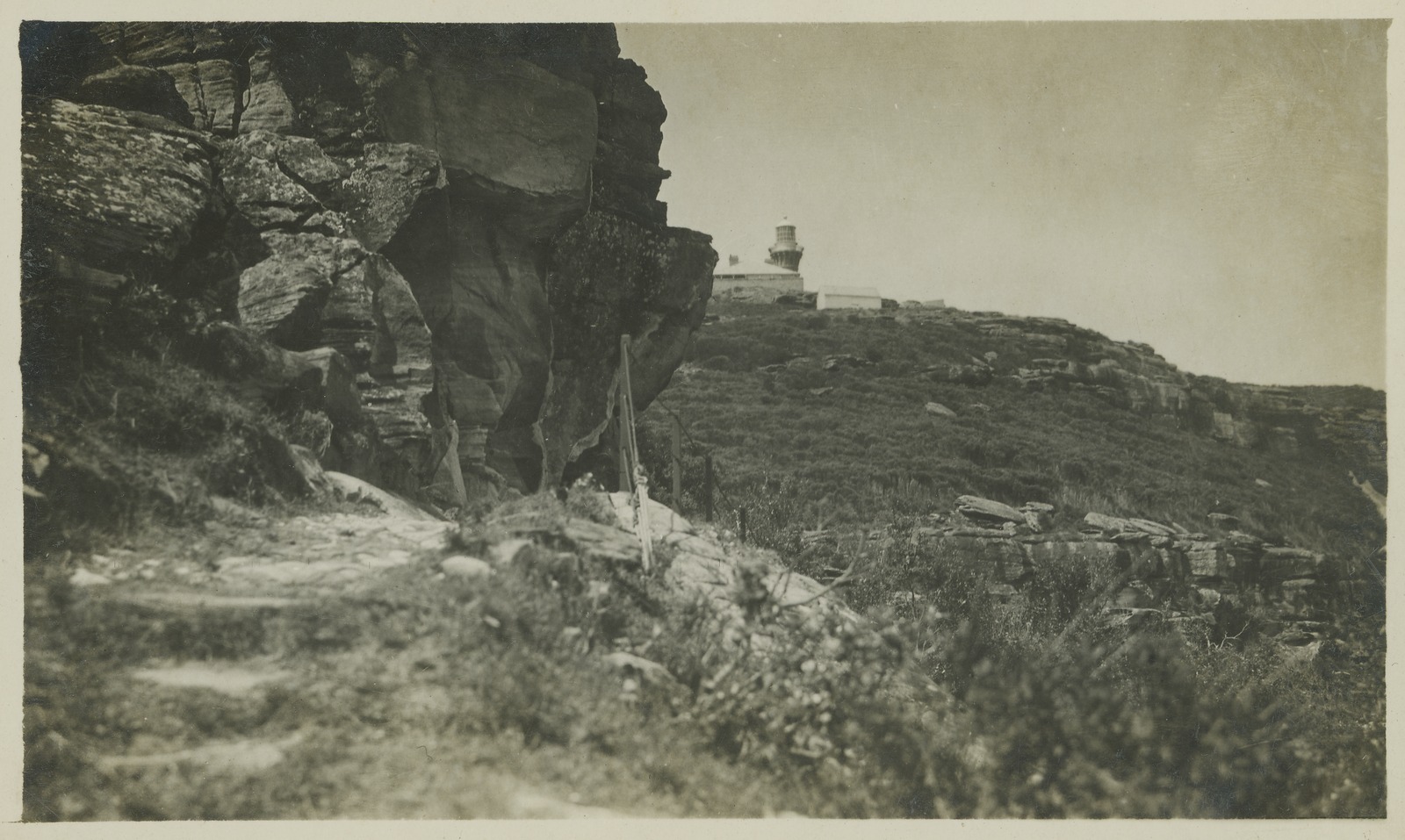
Barren Joey Lighthouse (Burrin Ju) [picture]. circa 1910-1915. Photo by A. J Vogan. Courtesy State Library of Victoria. Image H82.254/8/34
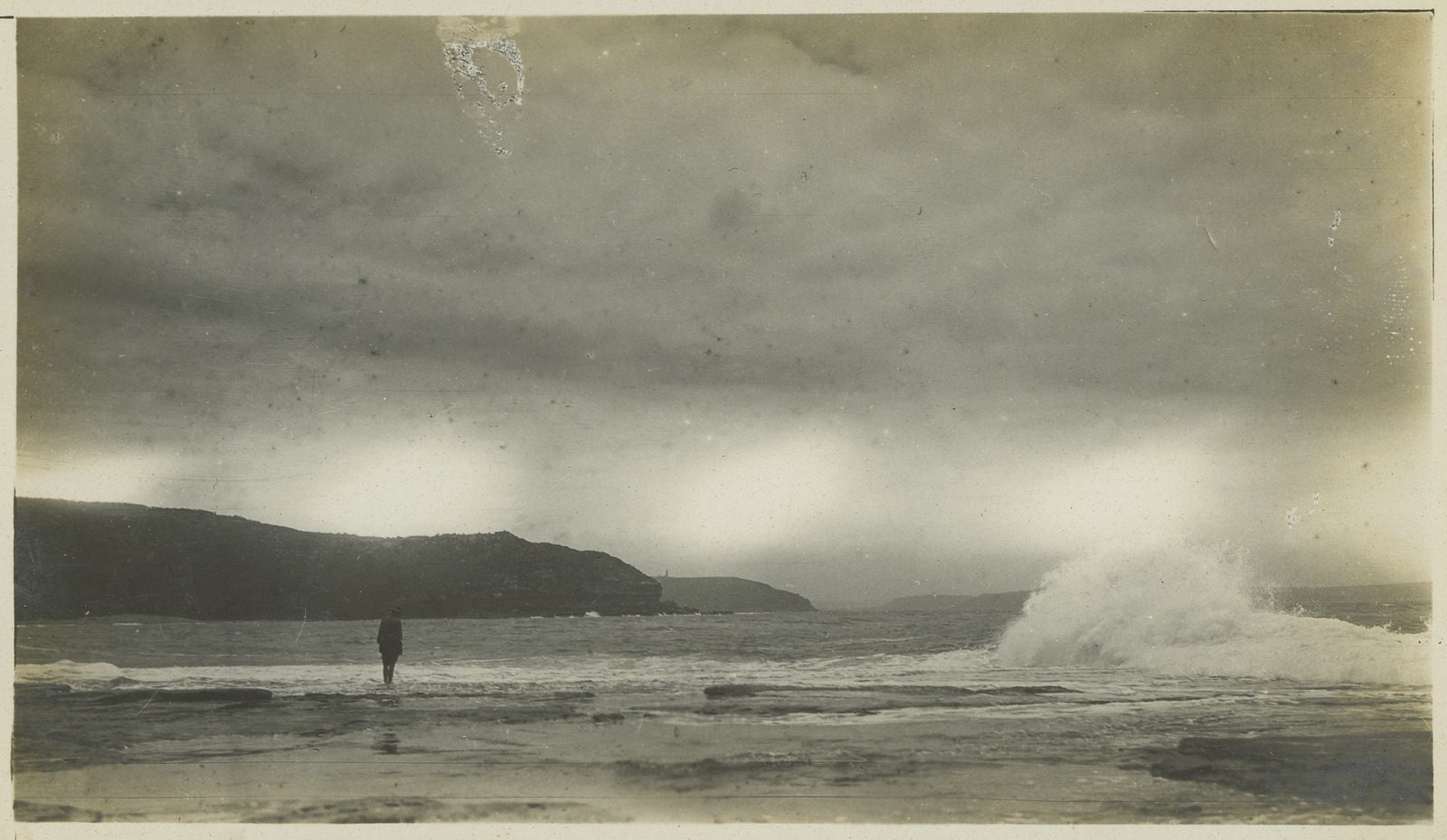
Barren Joe [Barrenjoey] Lighthouse, entrance to Broken Bay, 20 mins north of Sydney [picture].Photo by A. J Vogan. Courtesy State Library of Victoria. Image H82.254/8/9
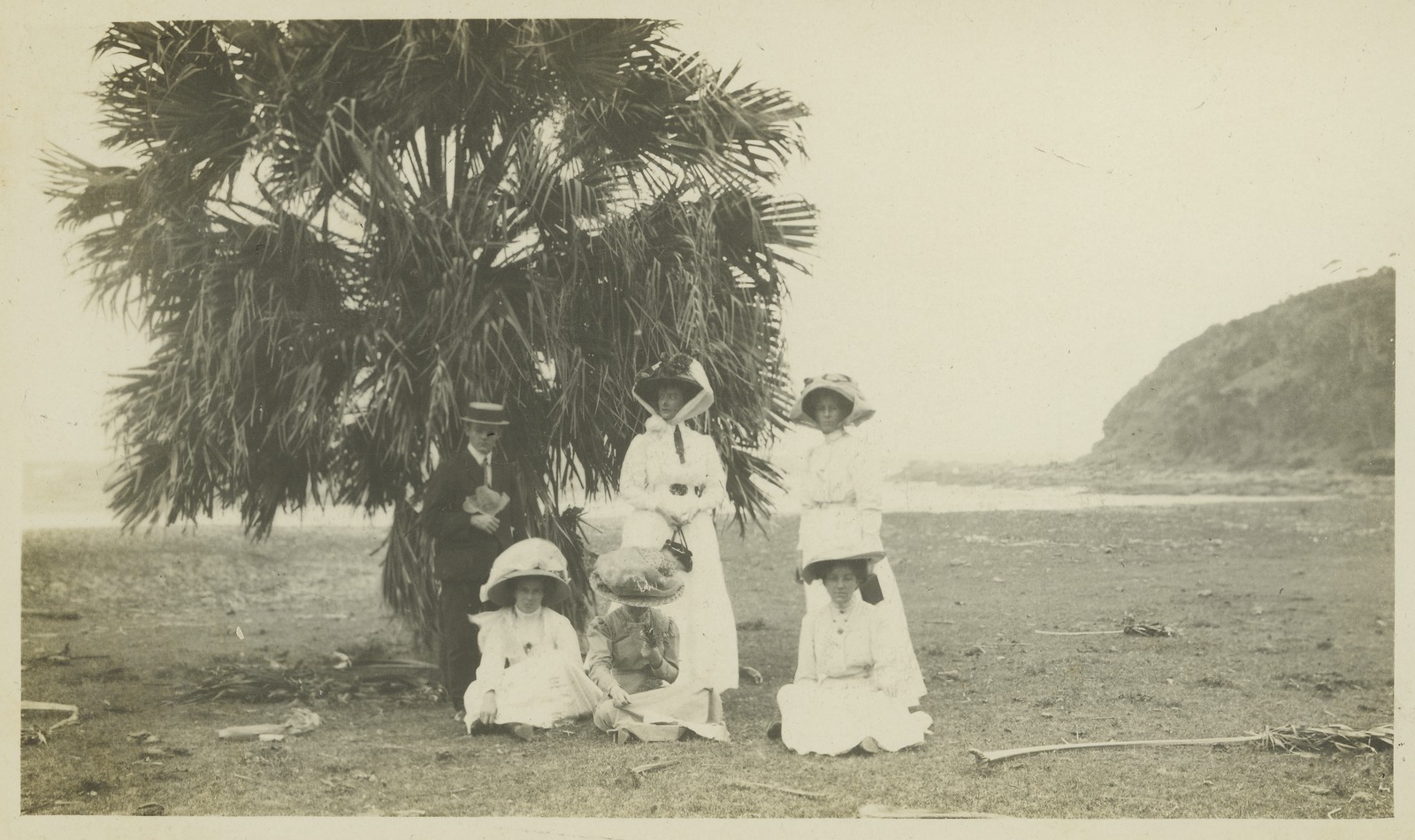
[Livintonia Australis (water palm)?] Whale Beach, Pitt Water, N.S.W. [picture].Photo by A. J Vogan. Courtesy State Library of Victoria.Image H82.254/8/18
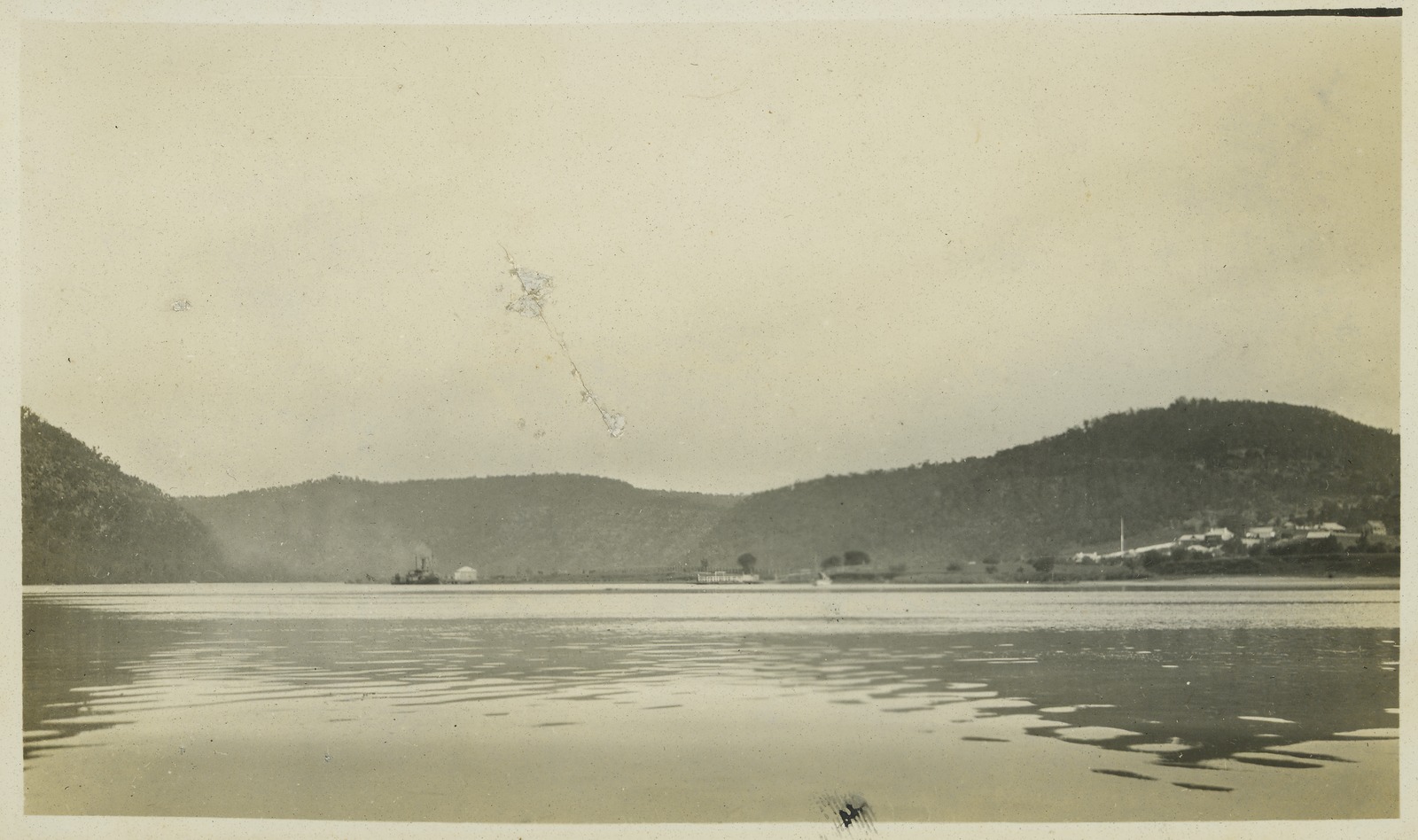
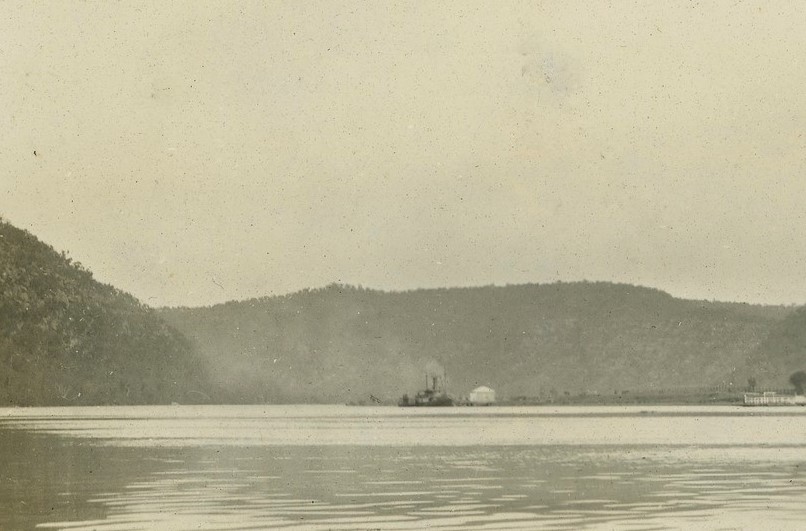
Entrance to [...?] [...?], Hawkesbury River [picture]. Photo by A. J Vogan. Courtesy State Library of Victoria. Image H82.254/8/44
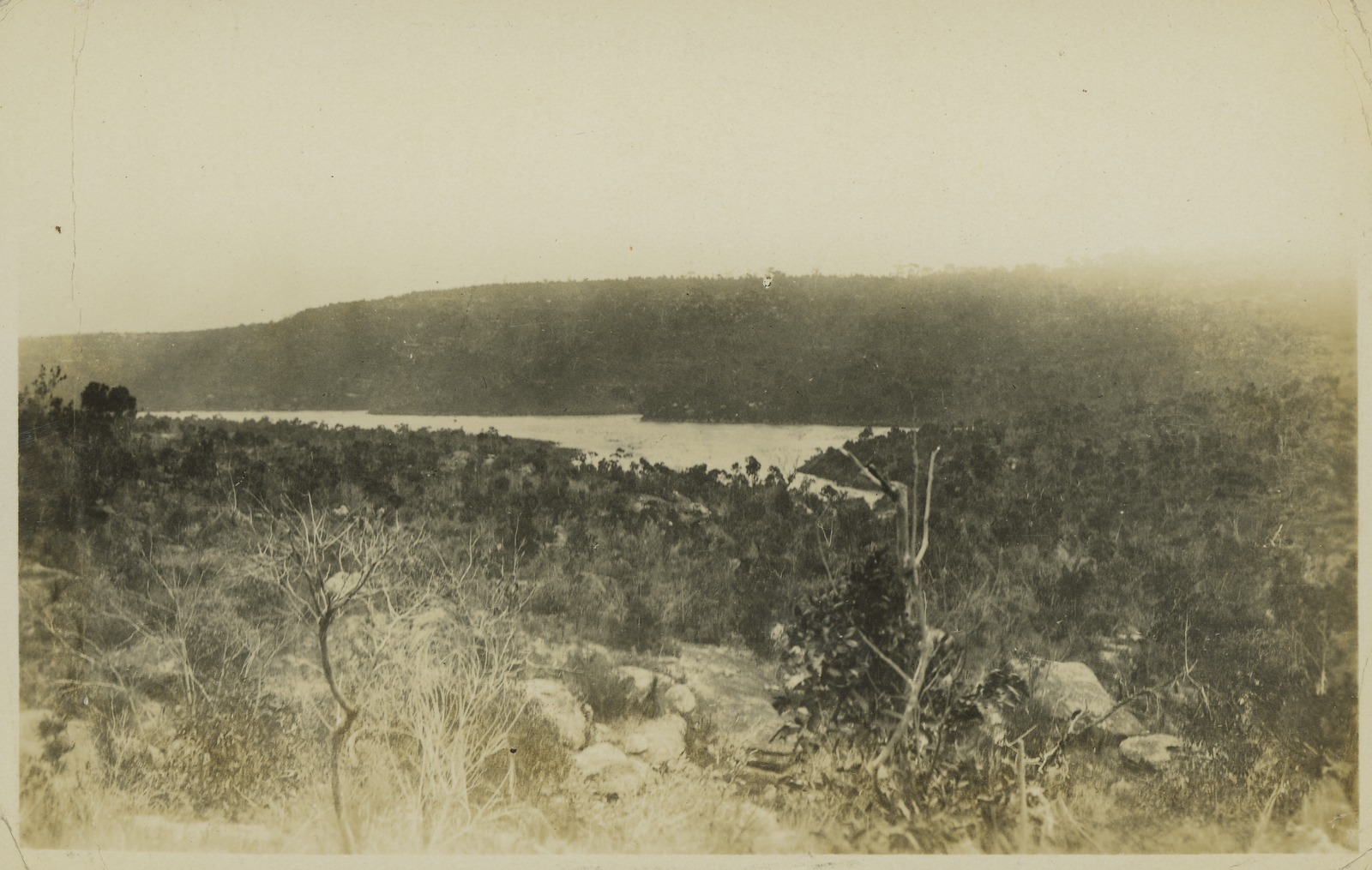
Fresh-water [ dam...?] supplying Manly with water [picture]. Photo by A. J Vogan. Courtesy State Library of Victoria. Image H82.254/8/27
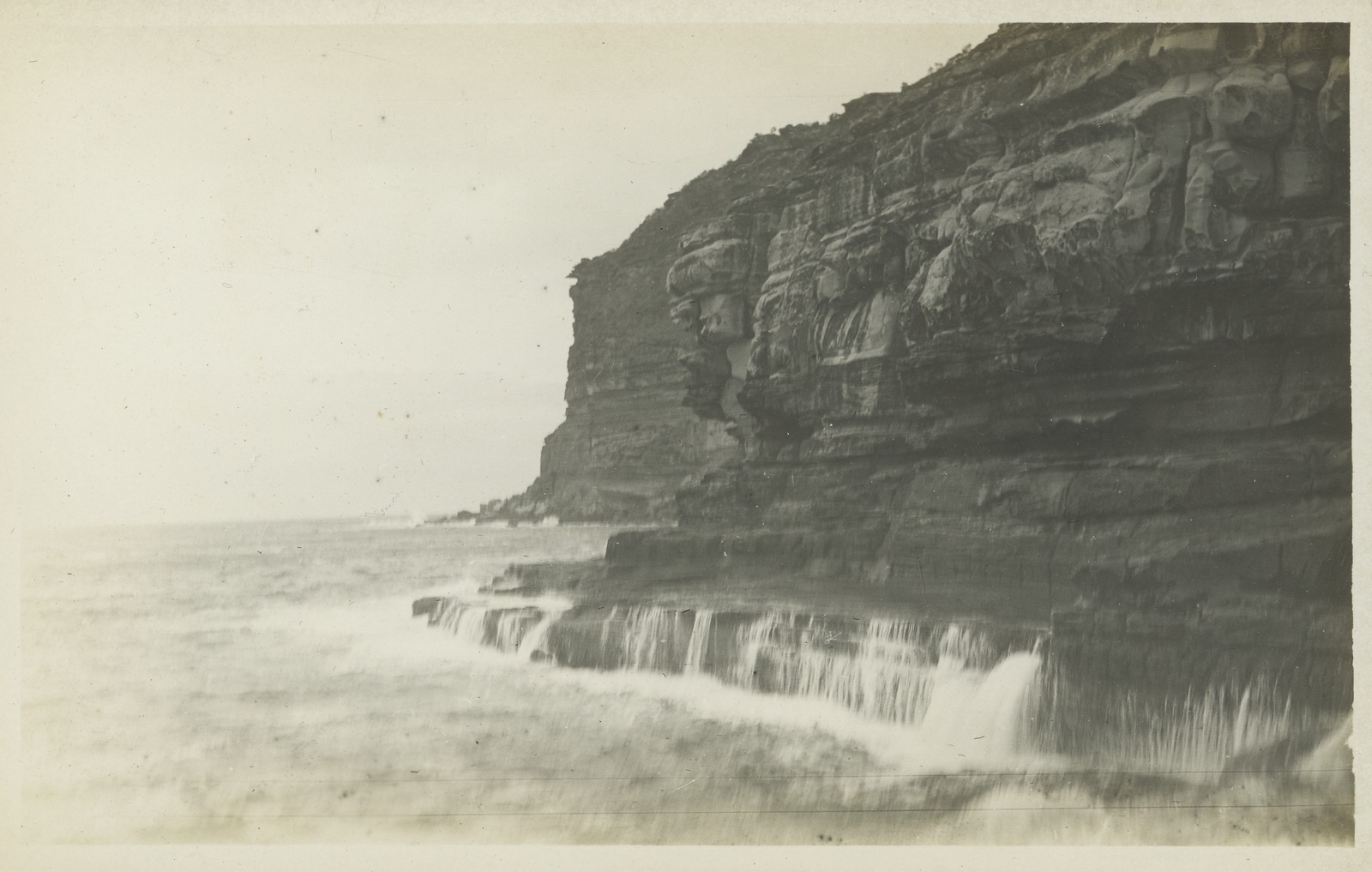
[Ocean crashing into cliff face] [picture]. Photo by A. J Vogan. Courtesy State Library of Victoria. Image H82.254/8/8
References, Extras And Some Of A J Vogans Writings
1. TROVE - National Library of Australia.
2. Denis Gojak. Arthur J. Vogan – forgotten archaeologist. Secret Visitors Project blog. Retrieved fromhttps://secretvisitors.wordpress.com/2011/12/31/arthur-j-vogan-forgotten-archaeologist-1/
IN the Estate of ARTHUR JAMES VOGAN late of Deewhy In the State of New South Wales Archaeologist, deceased. Application will be made after 14 days from the publication hereof that administration of the Will dated 23rd September 1947 be granted to Frederick Carr, Executor named In the said Will and all Notices and claims-against 'the said Estate are hereby required to be served at the undermentioned address within the period of 14 days. FREDERICK CARR, 127 Willoughby Road, Crow's Nest, Executor. Advertising (1950, May 2). The Sydney Morning Herald (NSW : 1842 - 1954), p. 12. Retrieved from http://nla.gov.au/nla.news-article27571725
HISTORY OF THE EXPEDITION.
The exploration of New Guinea was naturally one of the first objects which engaged the attention of the Geographical Society of Australasia, which is still in its infancy. During 1883 and 1884 the subject was frequently mooted, but it was not till towards the close of last year, when public attention was so strongly directed to the island, that the scheme assumed definitive shape. In January of the present year the administrative council of the society appointed a committee which was afterwards called the Exploratory Committee, which was entrusted with the work of organising the proposed expedition. This committee numbered eight members, viz.:--Dr. T. B. Belgrave, Lieut. E. R. Connor, R.N., Captain H. C. Everill, Mr. Lawrence Hargrave, Mr. lohn F. Mann, Mr. E. Marin La Meslee, hon. secretary, Mr. C. S. Wilkinson, Government geologist, and Mr. Harrie Wood, J. P., under secretary for Mines. The President of the Administrative Council, Sir Edward Strickland, K.C.B., Mr. F. Gerard, treasurer , and Mr. J. H Maiden, hon. secretary were also members ex officio. Mr. Hargrave had considerable personal knowledge of New Guinea, having accompanied D'Albertis in his expedition up the Fly River in 1876; and Mr. Munn is a well-known explorer, having been Dr. Leichhardt's second in command.
The Rev. W. G Lawes was in Sydney at the time, and his great experience, of New Guinea proved of great assistance to the committee, to which he was afterwards added. Captain Everill resigned his position as a member of the committee after the ninth meeting, he having then become an active candidate for the position of leader of the expedition.
The question as to what part of New Guinea should be explored was one which required the gravest consideration. The expedition of this year was at first in tended to be merely preliminary to more important operations next year, and at a meeting of the committee on February 9 it was resolved to restrict the operations to exploring the Aird or some other nur on the south coast. However, more ambitious projects were soon brought forward and it was proposed to explore the rivers in the south of the island, and also some portion of the interior. The proposals were discussed with the Melbourne branch by letter but the progress in this way was too slow, and it was therefore suggested that a telegraphic conference should take place between the councils of the two branches. The telegraph authorities in both Melbourne and Sydney gave their consent to the free use of a wire between the two capitals, and on the evening of March di the council of the Victorian brauch assembled at the Central telegraph office, Melbourne, and were put in communication with the council of the New South Wales branch at the General Post-office, Sydney. Some mern- bers of the council of the Victorian branch (of which Baron von Mueller is the president) were in favour of a land expedition direct from the coast, where it approaches nearest to the high lands. It was urged that the exploration of the Owen Stanley Range so far as it has been already traced, would afford ample work for perhaps a couple of years, independently of the researches now being made by Mr. H. O. Forbes. Port Moresby could then be made a base of opera-tions, and the work of exploration could be pushed steadily westwards and inland, as the party became more familiar with the country, and the real attitude of the natives was better understood. The great cost of a river expe- dition was also urged as an argument against the suggestions made that the expedition should at once proceed up the Fly River, and strike into the heart of the country, and into a region where, 10 years ago, Signor d'Albertis had to fight for his life and where only a few months ago another party of explorers had just as narrow an escape. The Sydney council urged that it was desirable to at once make a bold effort to get to the centre of New Guinea not only be cause of the greater probable results but because of the necessity for securing sub-stantial public sympathy in the society's work and the proposal of the exploratory Committee was submitted which was for an expedition up the Aird River, thence inland and that the inland exploration start from the first high land met with up the river, shown on the map as Aird hill.
The mouth of the Aird River is about two degrees above that of the Fly, and it would therefore be a much more advantageous starting place for an expedition whose primary object waa to reach the great moun-tain range which forms the centre of the island. The proposal was considered in Melbourne for about two hours, during which time the telegraph wire was frequently used to ask and answer questions on many matters of detail. Ultimately the message went from Melbourne, "We fall in with your wishes regarding Aird River Expedition."
No time was lost in selecting and equipping a party of explorers to carry out the resolution of the society. The council had already received promises of pecuniary assistance from several of the colonial governments. New South Wales gave £2,000 Victoria £1,000, and Queensland £1,000 so that a sum of £4,000 was available for the exploration of New Guinea. The selection of a leader required a good deal of deliberation. The Rev. W. G. Lawes was not strong enough to undertake the task. The Rev. J. Chalmers, who had for many years been engaged in mission work in the south-east part of New Guinea, was admirably suited for the post, but could not accept it.
Early in April applications for the position were publicly solicited, and out of a number of candidates, Captain H. C. Everill was finally chosen to take command of the expedition. For the secondary appointments the committee had nearly 200 applications from which to make choice, but it was re- solved that no volunteers should be taken, but that salaries should be paid in every case so as to constitute every one employed on the expedition a servant of the Society. The salaries allotted to the principal members of the party were as follow, per month:--Leader, £ 40, zoologist, £35 , surgeon, £30, sub-leader on board, £15 , sub leader on land, £15, assistant zoologist, £15 , general collector, £15 , photographer £15, botanist £15.
In the course of the instructions with which Captain Everill was supplied, the president wrote:--"Very strict rules should be laid down with reference to the use of firearms, and in preparing these rules one cardinal point must always be held clearly in view, i.e., it must be insisted upon that a native must never be fired upon except the life of a member of the party is in danger. Every one belonging to the expedition should be made to feel the necessity of adopting the spirit of this rule, and putting it in practice himself and enforcing its practice upon others, one shot fired with a fatal result would make me feel very despondent as to the success of the expedition, certainly it would immensely increase the difficulties of exploring. No precaution, therefore, should be omitted to avoid any such untoward event.
The plan of operations was clearly defined as follows:--"The council having decided to make if possible, the Aird River the basis of operations of the expedition, requests the leader to proceed thither from Thursday Island. The leader shall proceed up the Aird River until he finds a convenient land-nig place near to a hill marked on the Admiralty chart as Aird-hill. After leaving a party in charge of the steamer sufficient for its safety and protection, the leader shall proceed with the rest of the party, including the scientific staff, to Aird -hill, and if it be found that that hill forms part of a spur from the main dividing range in the interior of New Guinea he will follow up that spur as closely as he can to that range. In the event of Aird-hill not forming, part of a spur from the main range, the leader should ascend the first spur that he meets with on the same side of the river and follow it up to that range. The leader will make arrangements for keep- ing open a communication in his rear to the steamer as a deput so that he may be enabled to make his movements known, transmit from time to time the scientific objects collected, and receive any stores re-quired. In the event of the route by the Aird River proving impracticable, the leader will choose the first available estuary to the eastward thereof and from the depot there formed will proceed with his land expedi-tion on a similar basis to that laid down in the case of the Aird-namely, to ascend the first available high land mid work thence to the main dividing range , to attain and explore to the fuithest possible limit of that range within the boundary of the
British possession being the principal object of the expedition. On the completion of the exploration of the main dividing range as previouslly proposed, the expedition shall return to Thursday Island for the purpose of delivering under seal, into safe keeping of the Government Resident there, all specimens and records in their possession. And should time allow of further exploration of New Guinea, the leader, after consultation with the members of the expedition, shall decide upon the course to be adopted."
The steam launch Bonito, 77 tons register, was chartered from the A.S.N Company for six months to convey the party from Thursday Island to New Guinea. The expedition left Sydney on June 10, and Brisbane on the 17th, arriving, at Cooktown on the 23rd, and at Thursday Island on the 25th of the same month. The ascent of the Aird River, as resolved upon by the society, had been found impractible in consequence of the danger in crossing the Gulf of Papua from Thursday Island during the season when the south-east monsoons prevail, and Captain Everill ultimately resolved to enter the Fly River, and proceed up that stream until the last important branch from the north-eastward was met with. Neboo Island, at the mouth of the Fly River, was reached on the 17th July, and the expedition was there joined by Mr. J. Douglas the Government Resident at Thursday Island, and by the Rev. Mr. M'Farlane, of Murray Island, by whom the party were accompanied for about 30 miles up the river. Here Mr. M'Farlane endeavoured to obtain interpreters for the ex-pedition but without success, and at the village of Kewai the two visitors left Captain Everill and his companions to continue their perilous journcy into the "great lone land" of this quarter of the globe
THE PERSONNEL OF THE PARTY.
Tile following particulars regarding the members of the expedition are gleaned from the special record of the proceedings of the Geographical Society, and from other sources:--
Henry Charles Everill, the leader of the expedition, was 38 years of age, and had an extensive maritime experience,
having been at onetime commander of an East Indiaman. His certificates as master were of the highest class given. He had travelled a great deal, was for three years a tobacco planter in Sumatra, had practical knowledge of exploration in tropical swamps and jungles, and was able to speak the Malay language fluently. He therefore possessed many qualifications for the important posi-tion to which he was appointed.
Dr. J. W. Haacke, the chief scientist ol the expedition, was 30 years of age. He filled the posts of first assistant at the Zoological Institute of tile University of Jena, and first assistant at the Zoological Institute of the University ot Kiel, both in Germany. In New Zealand, he worked for Professor Parker at the Otago Museum, Dunedin, and for Dr. Haast, at the Canterbury Museum, Christchurch. Dr. Haacke was for some time in charge of the South Australian Museum. He succeeded to the position of curator there on the resigna-tion ol Mr. F. Waterhouse in 18S2, having previously been engaged in connexion with museums in New Zealand. He remained in his office for a little over two years, but then, owing to a certain disagrement with the board of governors, he was allowed leave of absence on full pay, at the end of which he sent in his resignation. His management of the museum was not an entire success, although he undoubtedly did much towards remodelling the institution when installed in its new buildings, Adelaide, last year. He had gained considerable renown for his studies.
Prior to his appointment as naturalist to the expedition, Dr. Haack had expressed his in-tention of proceeding to Ceylon and thence to Borneo or Sumatra, where he purposed earn-ing on his investigations. He was married while in South Australia to the daughter of a well-known German resident there.
Sidney A. Bernays, M.D., the surgeon of the expedition, was for some time in practice in Melbourne. His father is professor of che-mistiy at St. George a Hospital, London, and he was himself looked upon as a competent medical man. He was moreover, a scientist of no mean ability. Botany was his specialty, and the botanical department of the expedition had been put under his care Dr. Benays was 32 years of age, and unmarried.
Godfrey Hemsworth aged 28 of Brisbane, filled the post of nautical sub-leader, and in the event of death or serious illness of the leader he would take his position, except that he would not lead the party on land. He held a masters certificate, had been navigating officer of some of the finest steamers afloat was a member of the Meteorological Society of London, and was considered qualified to undertake any kind of marine surveying.
R. Gethin Creagh, aged 38, of the Manning River, who filled the post of sub-leader on land, was considered a most competent man for the work of exploration. He was six feet three inches high, with a strong constitu-tion, having, it is said, never known serious personal ill-health, he had had many years' experience of exploring, and in taking up and stocking new country in Queensland, South Australia, and New Zealand. He had had great experience of the aboriginals was a good shot with rifle and fowling piece, andi knew bush life in all its phases. In the event of the leader's death or illness, he would have taken his position on land.
James H. Shaw, age 27, of Sydney was a most enthusiastic explorer. He was 18 months in New Guinea with the expedition of Mr. Andrew Goldie, and spent a further six months with another party, of which, unfortunately he was the sole survivor. He had great experience of river navigation having sailed between three and four thousand miles in a Rob Roy canoe on Australian rivers. He was able to turn his hand to almost anything either ashore or afloat. The special duties assigned to him were those of a photographer and general assistant to the leader.
Walter W. Froggatt, of Sandhurst, Victoria, filed the post of special zoological collector and assistant to Dr. Haacke. His father is a well known mining investor in Sandhurst. Froggatt was an amateur entomologist and had a good practical, though not scientific knowledge of botany. He was 27 years of age and unmarried.
Wilhelm Bauerlen, aged 40 of Sydney, was the special botanical collector. He had been employed in this capacity by Baron von Mueller, on whose recommendation he was engaged for this expedition. Baurlen was a native of Wurtemberg and unmarried.
A Hastings W. Senior, aged 28, of Lismore, N.S.W., was a licensed surveyor, employed in the department of surveyor general, and had been some years at sea. His application was not received till late--owing to his absence inland--and it was declined at the time the main positions being filled. However, the very week the expedition left room was found for him as a supernumary at a trilling salary, the surveyor general kindly consenting to this abrupt suspension of his work.
There was no doubt that Mr. Senior was an acquisition to the expedition and his anxiety to do his utmost to promote its success was attested by the fact that he had taken with him scientific instruments and other articles of his own to the value of nearly £100.
Arthur J. Vogan, age 26, of New Zealand, was allowed to join the expedition at the very last moment. He had many useful accomplishment--was an artist, understood photography, taxidermy building huts and every species of bush work. He not only offered to go as a volunteer but tendered a subscription of £25 to the exploration fund. The subscription was declined but Mr. Vogan was appointed a supernumerary at a nominal salary. Mr. Vogan had provided himself with a first class personal equipment.
William M'Geehan, aged 22 the engineer of the steam launch, specially selected by Captain Everill, had already proved himself a good man. In the bad weather that over-took the Bonito while on the way to Brisbane he kept to his work almost without a rest for three days and nights.
In addition to the above another scientist Mr. Kendall Broadbent, accompanied the expedition as far as Thursday Island, but while there he was attacked by sciatica, and was compelled to return to Sydney. Mr. Broadbent's specialities would have been ornithology and taxidermy. Luckily the ex-pedition was considered strong enough in that direction even without his assistance.
FIRST DESPATCHES FROM THE EXPEDITION.
To give an interesting resume of the information that has reached us regarding the doings of the expedition since its departure from Thursday Island, we cannot do better in the first place than to quote from an interesting paper on New Guinea explorations read tit the last meeting of the Victorian branch of the Geographical Society by Mr. A. C. Macdonald, F.R.G.S. He said:--
"As the Gulf of Papua was prohibited the expedition decided to ascend the Fly River and following the first branch of the stream leading in a N.N.E. direction endeavour thus to gain the interior of New Guinea. Some difficulty was experienced in getting a proper outfit the cartridges provided--filled entirely with buck and swan allot-being useless for obtaining specimens to be preserved. Amongst the stores taken were large quantities of tobacco ("missionary's twist"), which, according to Captain Everill, is the current coin of the islands met on the route to New Guinea. Of the red beads that have proved so attractive to the black brother in every quarter of the globe there was also a considerable stock. Provisions were found to be very dear at Thursday Island. A sheep that according to Captain Everill, "would make a good masthead light without reflectors," costs 30s.
On the way to Mangrove Island the steamer got inside one of the "horns" of the Warrior reef, which has been imperfectly surveyed In this position it was thought rather an ex- traordinary thing to find pearl boats at work on either side of the steamer, which was got clear of the reef without even a bump.
.........THE CATASTROPHE IN NEW GUINEA. (1885, November 9). The Argus (Melbourne, Vic. : 1848 - 1957), p. 6. Retrieved fromhttp://nla.gov.au/nla.news-article6072168 - in full in PDF below
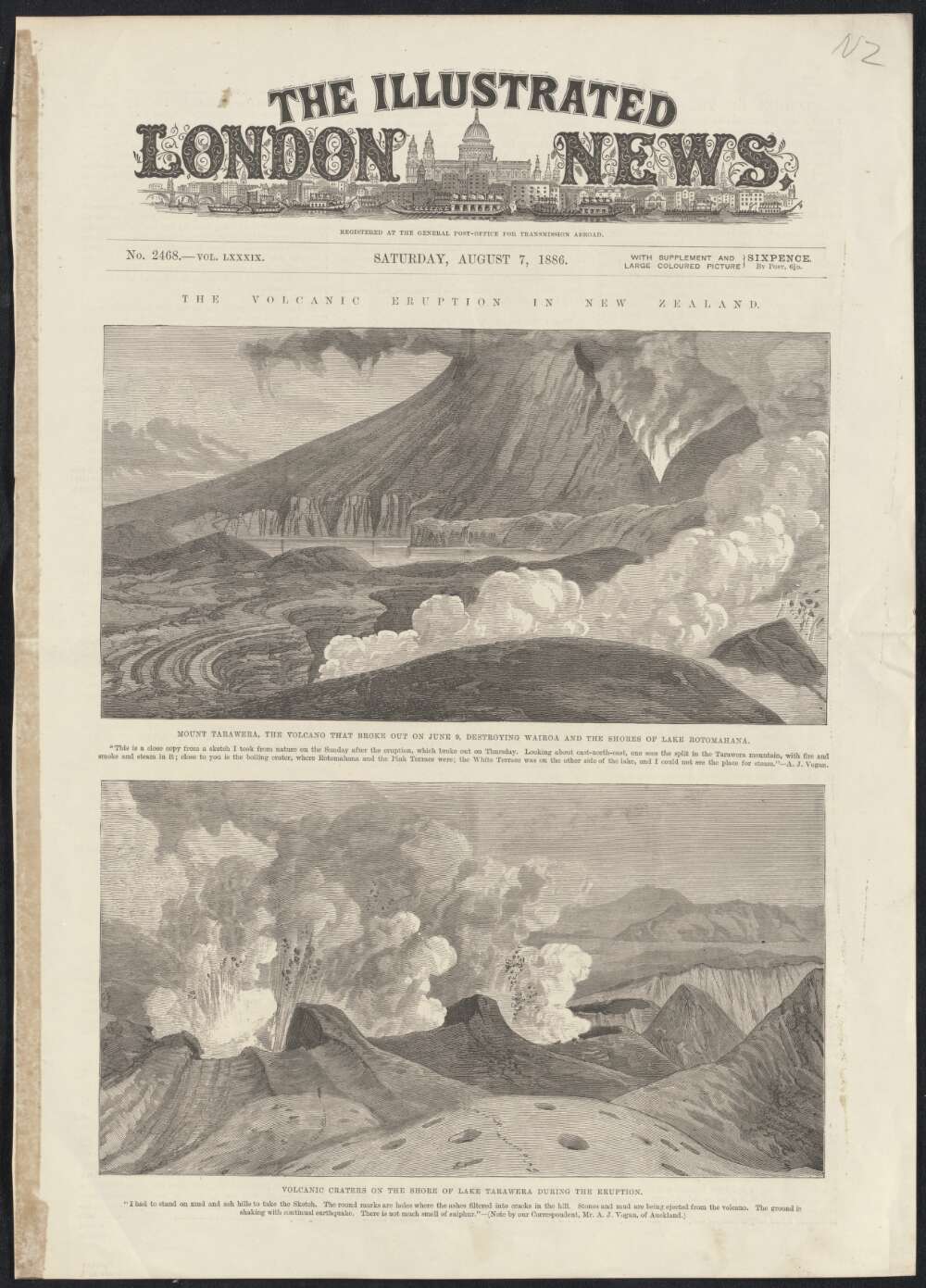
Vogan, A. J. (1886). Mount Tarawera, the volcano that broke out on June 9; Volcanic craters on the shore of Lake Tarawera during the eruption Retrieved from http://nla.gov.au/nla.obj-136178517
The Black Police. An Australian Story. By A. J. VOGAN. London : Hutchinson and Co.
Mr. Vogan aims at too much in his Australian story. And the result is an inartistic narrative in which the main purpose of the writer - to denounce the atrocities committed against the Aborigines of Northern Queensland by white men under the authority of law - is made subsidiary to a somewhat ingenious plot against the hero.
The book is by no means pleasant reading, and the structure of the tale is defective. The reader's interest is perpetually diverted by dissertations - good enough in their way - upon the scenery and flora and fauna of the region. The material, properly used, would make a good story, and perhaps Mr. Vogan may try again. We should judge from the evidence of the book that he writes from knowledge gained at first hand, and therefore there is no lack of true local colouring.
Reviews. (1892, May 12). The Maitland Mercury and Hunter River General Advertiser (NSW : 1843 - 1893), p. 7. Retrieved fromhttp://nla.gov.au/nla.news-article19009812
THE BLACK POLICE
VOGAN'S VEHEMENCE. "The Bloody Spirit of Settlement."
DARK DEEDS OF DASTARDLY "DISPERSERS" Calibans in the City: Blood-Drinkers in the Bush.
No. III
A. J. Vogan's book, "The Black Police", is a work that never received the recognition which it deserved. It is true that it is a work, of fiction, but what it has to say about the Native Mounted Police of Queens-land is founded upon fact; and is supported in Vogan's book by extracts from news-papers, and by other evidence. Moreover, apart from what the book says about the Black Police, it possesses some literary merit, and it deals with other aspects of Australian life.
For instance, there is a reference to the crowds that throng Paddy's Market in Sydney that is worthy of par-ticular attention by all those who well to Australia, for it contains much truth. Here is what Mr. Vogan has to say on this matter:— One of the first things, that would, strike a thoughtful observer of the habitues of Paddy's- Market- is the number of young people to be seen there, that is, persons under 21 years of age. Of course anywhere in the Australian colonies, save, perhaps, in some parts of Tasmania, the balance of population will be found to be in favor of youth rather than age, but here there are far more than one would expect to meet at such a place and at such an hour, for it is past 11 o'clock. Numbers of those young people are pale-faced girls of tender age, who, earning their livelihood at the big warehouses or millinery establishments of the city, laugh at the discipline of home (too often far away "up country"), and are rapidly following that easy path that, with ever-increasing docility, will likely land them ultimately amongst the unfortunates of the pavements. The "pals" of these young damsels are also there by scores. Most of these have been "turned out" after one general pattern; and, to use another mechanic's term, are chiefly "wasters". The same disgusting, unnatural, and unhealthy manikin appearance distinguished all of them. There is hardly any sight more pitiful to behold than these youthful bodies, that ....
THE BLACK POLICE. (1907, January 27). Truth (Brisbane, Qld. : 1900 - 1954), p. 11. Retrieved from http://nla.gov.au/nla.news-article198984698
Genesis: Island of Lies
How ideas arise and develop: Gillian Coote made some notes on the process of making Island of Lies under the AFC/ABC Documentary Fellowship Scheme, without which the film would not have been made.
Preamble...1988.
Before he went north to live in Batchelor for a year, my friend Allan Marett, an ethno-musicologist with a particular passion for Japanese music, told me he was dreaming of writing a No play about Eliza Fraser, the English woman who ... the Saltwater Blacks on Fraser Island and the mainland, before being rescued. Eliza told her story in a fairground tent, a story of savages and their despicable acts of cruelty, which Londoners were keen to hear at the time, a story which reverberates through time.
...
Eventually I found potential archival material in Charles Chauvel's Uncivilised, Heritage and Sons of Matthew. A late 19th century novel, A. J. Vogan's The Black Police (published in the 1890s) had the words of a chillingly jolly post-massacre song, sung by the killers, which I asked my old friend Kevin McGrath to set to appropriate music. On a subsequent research trip I met Ethel Richards, a descendant of the Batjala people of Fraser Island, whose aunt had been shifted to the mission at Yarrabah north of Cairns in 1904.
...
Genesis: Island of Lies (1991, June 1). Filmnews (Sydney, NSW : 1975 - 1995), p. 17. Retrieved from http://nla.gov.au/nla.news-article213877677
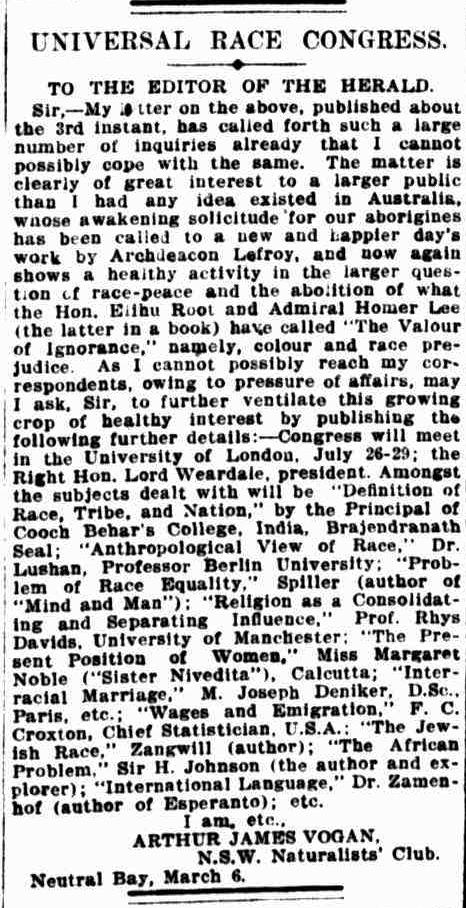
UNIVERSAL RACE CONGRESS. (1911, March 10). The Sydney Morning Herald (NSW : 1842 - 1954), p. 12. Retrieved fromhttp://nla.gov.au/nla.news-article15210784
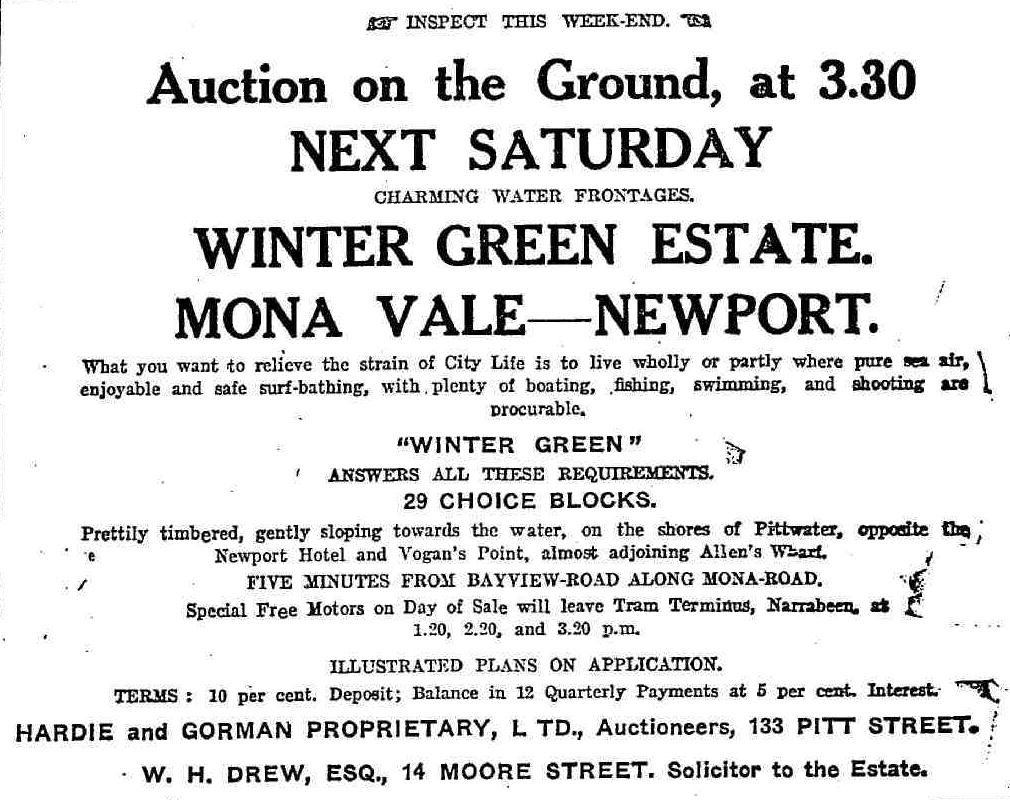
Vogans Point Newport Mona Vale Land sale. (1913, October 19). Sunday Times (Sydney, NSW : 1895 - 1930), p. 3. Retrieved fromhttp://nla.gov.au/nla.news-page13507509
Messrs. Hardie and Gorman will conduct a sale today at Newport, when the Winter Green Estato will be submitted. This land has good water frontages. There are 29 choice blocks, prettily timbered, gently sloping to-wards tho water, on tho shores of Pittwater, opposite the Newport Hotel and Vogan's Point, almost adjoining Allen's Wharf. The estate is five minutes from Bayview-road, along Mona-road. Special free motors will leave tram terminus, Narrabeen, at 1.20, 2.20, and 3.20 p.m. TO-DAY'S SALES. (1913, October 25). The Sydney Morning Herald (NSW : 1842 - 1954), p. 9. Retrieved from http://nla.gov.au/nla.news-article15460531
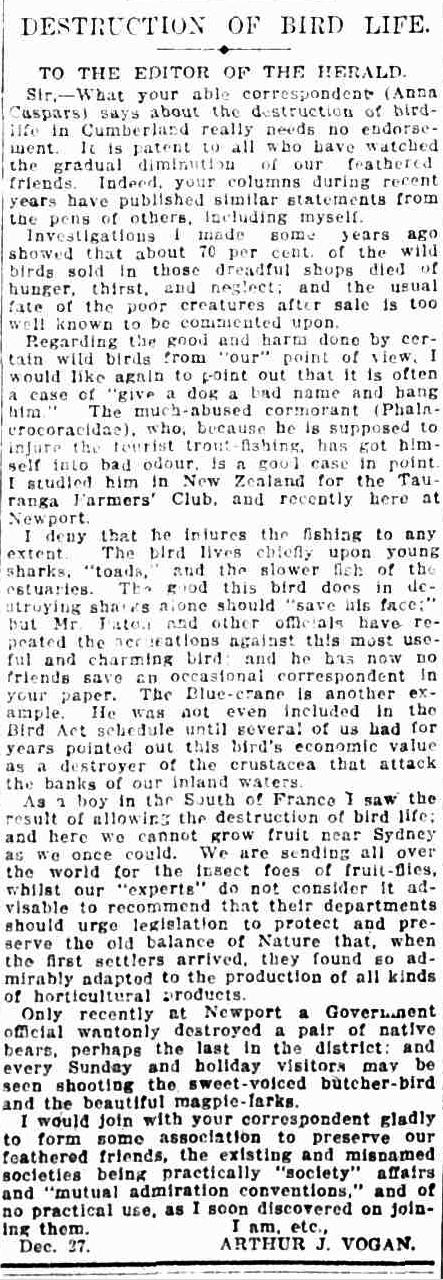
... and recently here at Newport .... As a boy in the south of France ....DESTRUCTION OF BIRD LIFE. (1914, January 17). The Sydney Morning Herald (NSW : 1842 - 1954), p. 6. Retrieved from http://nla.gov.au/nla.news-article28118639
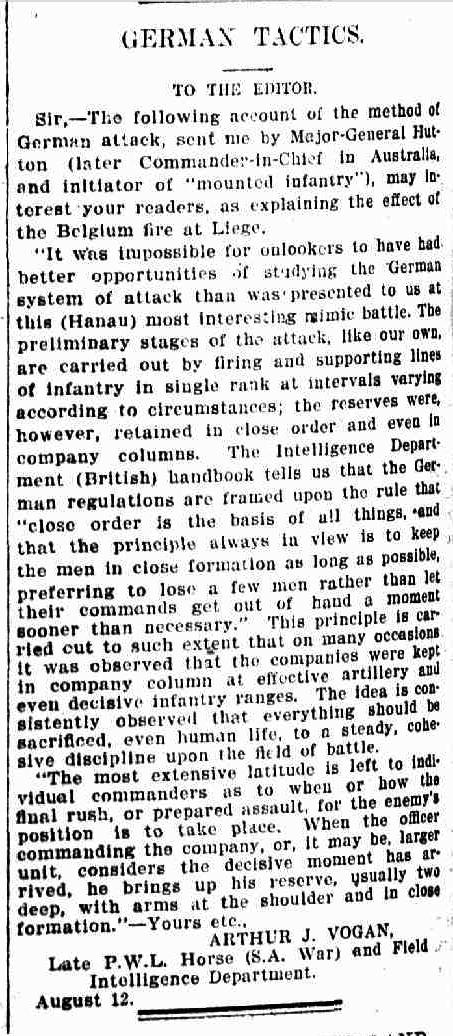
GERMAN TACTICS. (1914, August 13). The Daily Telegraph (Sydney, NSW : 1883 - 1930), p. 4. Retrieved fromhttp://nla.gov.au/nla.news-article239065113
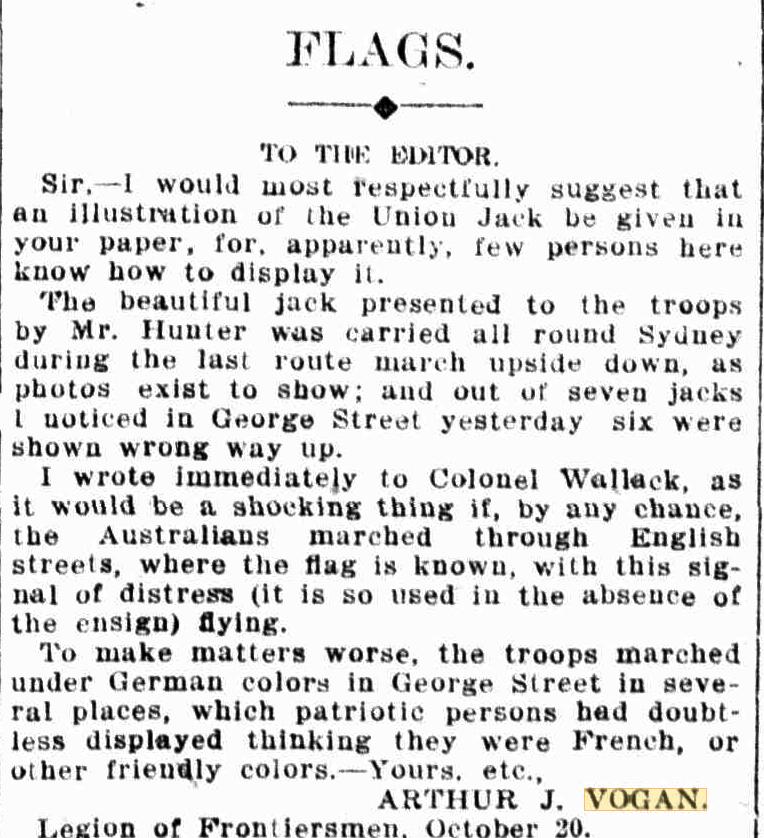
FLAGS. (1914, October 21). The Daily Telegraph (Sydney, NSW : 1883 - 1930), p. 11. Retrieved from http://nla.gov.au/nla.news-article239616183
DOGS AND MEN.
Dear Worker,— As a boy I was privileged to be constantly with Harrison Weir, the famous animal artist, and Jenner Weir (his brother), who Darwin so often mentions in his dissertations on pigeon-breeding. It was a favorite saying of Jenner Weir that all science should have for its objective the practical utility of the researches made.
The democratic spirit of a later day — especially in Australia — has developed this spirit, which was comparatively rare in the days when the Weirs were visitors at my father's house. Both Weirs used to say that the dog was nearer man in mentality in many ways than the ape, especially in, the budding sense of what I will call 'morality.' (I forget how these great men expressed it.)
Whilst travelling over a goodly portion of this globe I have had occasion to use dogs for many and varied purposes, including packing ammunition or water, or communication with friends over difficult country. Always has it been borne in upon me that these animals were essentially 'brothers.' Their health, their mental processes, their passions, and their food are similar to their masters, if on a lower plane in certain cases.
Mankind has recognised this throughout the world, and the remains of dog gnawed bones amongst the debris of the caveman, as reported from France, seems to indicate that even in those early years of civilisation our forebears had selected this animal from all the wild life teeming round them for their first domesticated animal. Even in the Orient we have their re-cognition. The fall of the Turk has curiously dated from the day when the Dogs of Bagdad and of Stamboul became 'civilised off the face of the world.'
The established custom, ordered of Mahammed, of the town official going his daily rounds with his bundle of cakes, was characteristic of the Moslem peoples, habitually mindful of their duty towards the humbler creation. Interesting as exampling the 'origin of conscience' in certain dogs, I may as well retell a historette long since sucked in by greedy boyish ears from a military relative from the East. From time out of mind Harunu' r Rashid's (typical) eastern city 'emporiums' have consisted of absolutely open shops. Goat and mutton joints are hung where any man or dog can reach them. The Turkish soldier, whose pocket is always empty, may help himself to a double-handful of what he desires, with no thought of payment on either side. But the dogs have no such privilege. The principle of heredity surely is inherent in castigation as in all other matters connected with biology.
For countless generations the first glance of one of these wandering guardians of the eastern towns has been visited with the swift decent of the cudgel or hatchet.
Now to my relative's story. My cousin purchased two great greyhounds at some city of the East, but found they would neither eat the meat he offered nor drink the water from the pan placed before them. They were suffering the pangs of hunger and thirst when their master (at his wit's end to save them) asked a Persian muleteer about them. This man put matters right at once by throwing down the meat and water upon the ground, when both dogs ran in like the Trojans, and made up in a few minutes for two days' fasting! I forget what moral my relative drew from this— in those dear days all our elders 'improved the shining hour,' or story, in this way. But we, to-day, can gather from this true story (which I could corroborate by a hundred pages of personal experience of the powers of hereditary influence on sheep and sporting dogs had I space), much useful and solid base, upon which to erect our perpendiculars of speculation and construction in educational matters concerning our own race. Next to conscience in importance to civilisation comes perhaps food. How alike are dog and man here!
Our fore- fathers knew that no meat was fit for consumption until certain- chemical processes had taken place to eliminate the fear, exhaustion, and other toxins present in the blood of the victim of their carnivorous promptings. There was no indigestion then, when all meat was well hung. To-day, when we eat our beef or mutton stripped from animals that had suffered cruel days in sun-baked, waterless trucks and yards, their little minds terror-stricken and storm-murked with semi-madness from overdriving, and the many hideous slaughter, the meat is full of poisons that — as Lombroso said of our social evils — cruelties of our inhuman - system of 'we deserve.'
It may sound horrible, but no capable medical man will deny the sayings of Major-General Tweedie and Surgeon- General Broke-Smith that all meat should be in the first stages of decay ere it be eaten. Now the dogs have all along known this. From the daintiest Pekineese or Sky to the common or garden 'tripe-hound,' one and all prefer a piece of carrion to fresh (and toxined) flesh. In these days, when our morning papers discuss the foulest diseases of the city for our innocent daughters to read at breakfast time, I need make no apology for referring to another subject. Nowhere is rabies known where the dog is free to mix with his kind, and breed as nature directs. Every theory of the origin of this breaking down of the grey matter of the cortex has failed save that of the old foxhound masters of a past generation. I have only to remind my readers of the one parallel that the average man will call to mind: that of the 'rogue' elephant.
But to those whose walks of life have enforced them to learn something of 'athar,' or the art of camelry, we have a very similar, nay, identical example, in the 'musti' or love-mad camel. It was long since pointed out by one of St. Bart's professors that the growth of certain forms of insanity was in exact proportion to the rise in the average age of marriage in England. The complete absence of restriction on acts of reproduction is so closely connected with the mental health of both men and dogs that it stands out as a matter that deserves our most serious and immediate attention. The movement — the timid movement made recently by the authorities in a certain direction regarding a disease with which Dr. Jarvie Hood declares half our youth are to-day afflicted, is merely a snipping off the heads of the briars. Youthful marriage, cheap living, and the removal of the constantly increasing taxation of the married couple is the only sane and immediate step we should take. Here we can 'go to the dogs' for guidance with all safety and relief.
Before closing this already perhaps too lengthy letter I ask to be allowed to again raise my feeble protest against the method employed here and elsewhere of judging dogs at our agricultural shows and elsewhere. Indeed, we can include our horses and cattle in the same category.
I was bred up amongst Suffolk-punch a boy and I lived in the Channel Islands as a youth. I solemnly declare that the animals shown up there at Moore Park and elsewhere are no more Punches or Guernsies, or fox-terriers, or Irish terriers than I am a negro.
Every year some innovation creeps in to suit some particular school of judge's idea, and in a few years the animal, although very possibly representing the best type towards which the local breeders have been directing their efforts, has no right whatever to the old name. The Irish terrier, for example, 50 years or so ago was a curly-haired, rough coated dog, with prick ears, hairy at the point; the fox terrier (I owned one of the pure Isle of Wight prize-takers of the early eighties) was a wide-chested, fox-nosed, small-headed animal, not a lanky, loose-jointed, nondescript such as gets the prize to-day. The Guernsey breeder would never keep an animal with any white about him or her. We see them in the shows half white, and twice the weight of any in the islands. The Punch was never over 14 hands. They are simply Shires we give the ribbon to at our shows to-day.
A. J. VOGAN.
DOGS AND MEN. (1915, May 20). The Australian Worker (Sydney, NSW : 1913 - 1950), p. 18. Retrieved from http://nla.gov.au/nla.news-article145786096
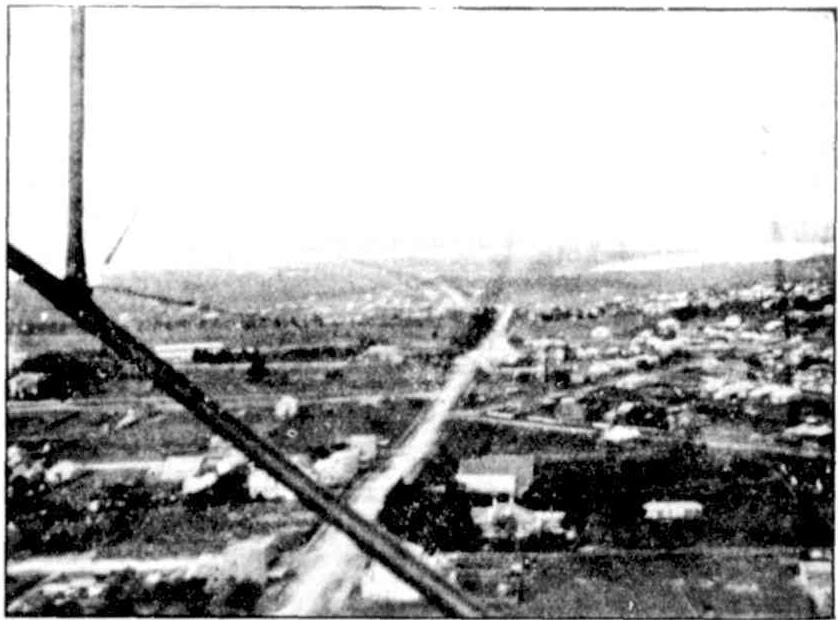
BUNNERONG ROAD, BOTANY
Photographed from an aeroplane by A. J. Vogan, F.R.G.S.
AVIATION UTILITY (1919, December 29). Construction and Local Government Journal (Sydney, NSW : 1913 - 1930), p. 12. Retrieved from http://nla.gov.au/nla.news-article108987704
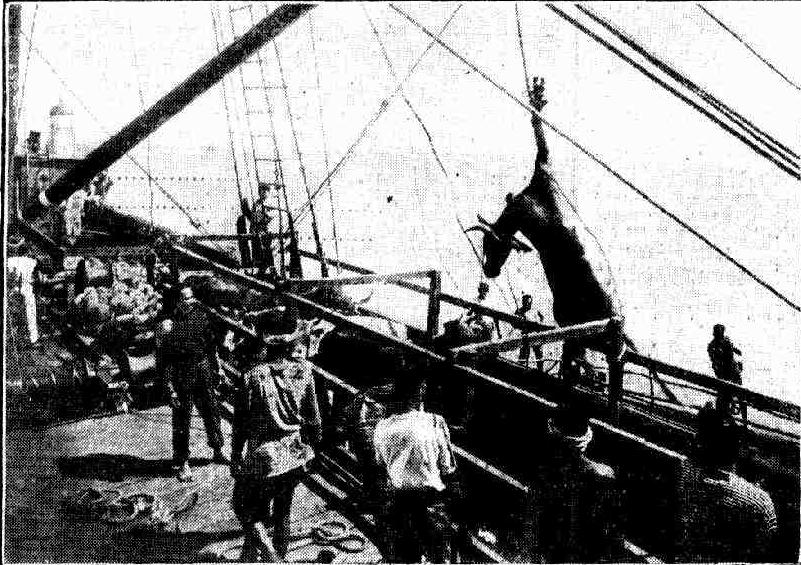
SHIPPING CATTLE IN NEW CALEDONIA: This photo was secured by Mr. Arthur J. Vogan on his recent visit to the islands.
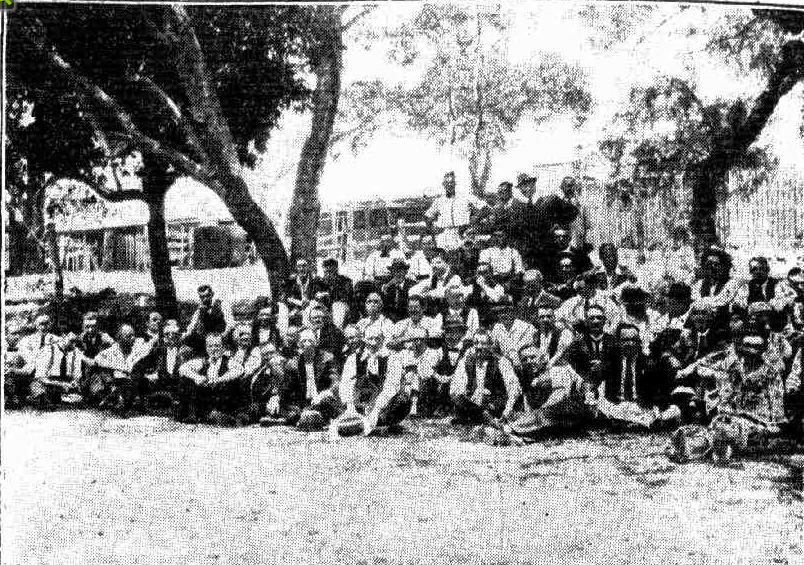
The Northern Commercial Travellers' re-union at Newport. On this occasion they voted £800 to provide dental department for tho Royal Alexandra Hospital for Children.
NEWS IN PICTURE-- (1923, December 21). The Daily Telegraph (Sydney, NSW : 1883 - 1930), p. 12. Retrieved fromhttp://nla.gov.au/nla.news-article245991586
WOMEN'S LEAGUE.
ADDRESS BY MR. VOGAN.
At a meeting of the Women's League of New South Wales at Bathurst House yesterday afternoon, an address was given by Mr. Arthur J. Vogan, F.R.G.S., on the treatment of aborigines in Queensland and the Northern Territory.
Mr. Vogan said he hoped that woman coming into politics would mean a change from the method of settling the native question in favour of the large pastoralists employed by governments of men only. Recent blood-tests by Australian and American scientists had shown that the aboriginals came of a stock allied to our own; and evidence was overwhelming of the intellectual capacity of the Australian natives, who were far in advance of most island people of the Pacific.
Our aborigines had been maligned by folk desiring to obtain their land, on the principle of "Give a dog a bad name." He advocated giving the missionaries of certain Churches protection and making them responsible over areas, as was so successfully done by the French in New Caledonia. Many thousands of aborigines could be usefully absorbed into a self-paying coastal guard, which would stop the present unmolested influx of drugs and Chinese into Australia.
WOMEN'S LEAGUE. (1926, August 19). The Sydney Morning Herald (NSW : 1842 - 1954), p. 5. Retrieved fromhttp://nla.gov.au/nla.news-article28057707
...
It was in these explorations that Mr. Vogan; first saw the Crater lakes which he said were shown to him by an old bushman who was-prospecting on Limestone Creek. In those years the country about the lakes was the haunt of aborigines; and the natives believed the lakes to be sacred; and adopted a hostile attitude'towards the would-be discoverers. - One favorite method, of attacking the-white' trespassers was to allow the whites to reach 'the bottom cf the hills .and hurl boulders at them!
On his return from .the plateau Mr. Vogàn. wrote the first description of the lakes and the discoveries were set forth in a book, "-''The Black Police," which was published by Hutchisons in 1889. -..
THE EARLY DAYS. (1931, June 3). Cairns Post (Qld. : 1909 - 1954), p. 4. Retrieved from http://nla.gov.au/nla.news-article48708272
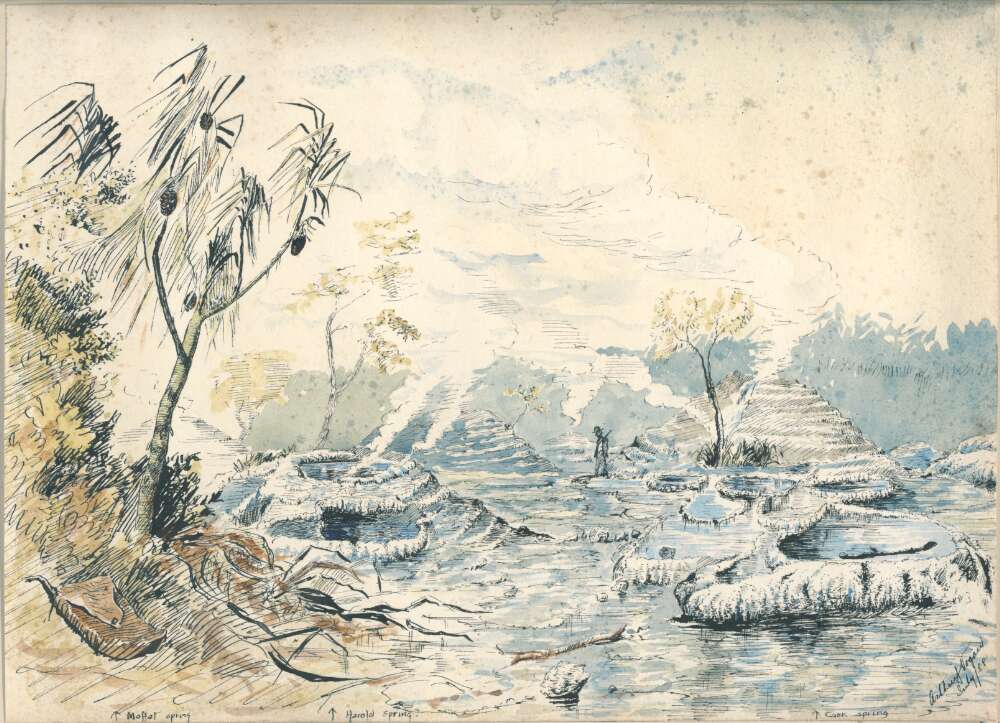
Vogan, A. J. (1900). Scrapbook of Arthur James Vogan Retrieved from http://nla.gov.au/nla.obj-136188312
MR. A. J. VOGAN, of Kuringai, Pymble, was host at 'a delightfully informal party at Pearson's Cafe last week, when he entertained a few of his friends at luncheon and told them the plans for his forthcoming trip to New Caledonia. The table was decorated with a basket of passion flowers, roses, and carnations and with vases of roses. Hand-printed novelty cards marked the place of the guests, amongst whom were Mrs. C. A. Messmer, Mrs. Wallace, Miss Thea Cowan, Dr. Purdy, Mr. W. P. Goodwin, and Mr. R. W. Robson. Women's World (1932, May 18). Sydney Mail (NSW : 1912 - 1938), p. 20. Retrieved from http://nla.gov.au/nla.news-article160081065
UNKNOWN LAND
Archaeologist's Interest
MR. A. J. VOGAN CRITICAL
Mr A.J. Vogan, F.R.G.S., who is visiting Newcastle, said yesterday that he contemplates settling down in this city to write his book upon his quarter of a century of inquiry into the prehistoric peo-ple of the Western Pacific. "I am better, known in Paris, London, and Washington than here in Australia, where I live," he said, "for you folk take no interest in anything but rolling balls about the grass - just now, anyway. You don't know anything about your own country, even!
In 1887, when I was artist for the 'lllustrated London News,' I chanced to discover, on the River Einsleigh, a group of beautiful thermal springs, and highly picturesque basins, such as were destroyed in the Hot Lake district of New Zealand in the Tarawera eruption of June 10, 1880; which I was through.
I did all I could then, and since, to get Queensland Governments to protect this wonderland, but they have been broken down to build cowsheds of, I understand. The many wonderlands of the Pacific are also quite unknown to Australians. Americans and other folk visit these exquisite places, but Australians know that there is no cricket player there and the coral -formations and isolated positions of the beauty spots prevent race courses appearing -- save in New Caledonia; and the yearly meeting is more comic than serious. Civilisations have come and gone here in the Pacific, as elsewhere; and, apparently, the mosquito (from South America)ri wiped out what would have been a very promising island empire of cultivated Asian immigrants, about 800 years ago."
SUN-WORSHIPPERS.
Mr Vogan mentioned that he had traced the evidences of the presence of the old sun-worshippers from away down in Southern New Zealand to the Trobriands and Lusancy Islands, in the far North. "In one village in this group," he said, "I found what I had so long been seek-ing for - the little adulterated Asian type, who flowed over the Pacific thousands of years ago, bringing with them their cultures of sun and nature worship, medicine, surgery, fire-walking, and navigation. They mostly came by way of the northern coasts of New guinea; but here they were gradually absorbed into the aboriginal populations - sometimes by marriage; but often under the less romantic circumstances of tribal dinner-parties. The first inhabitants of the Pacific, as in Africa and in Europe, were pigmies; and we find remains to- day not only of these diminutive folk in New Guinea, Fiji and other places, but their language contains so many words which are the same as those used to-day upon the Niger, and elsewhere in the great Dark Continent, that there can hardly be any question that their remote ancestors existed when the islands of the Western Pacific were joined with Australia and Asia; and the latter with Africa. Many are the other evidences for this. For in-stance there is a hill in the North Island of New Zealand which has the old Indian word for snake [naka] attached to it; as in Iceland there are no snakes in Maori-land. But the ancestors of the splendid race who came there [far earlier than the time of Queen Elizabeth, as is generally taught] were from the Delhi district of India, by way of the Sindho or Indo River, where the dialect still contains Maori words and where snakes are an ever-present feature of the landscape."
ANCIENT INSCRIPTION.
Mr Vogan discovered the only ancient inscription yet found in the Pacific, two years ago, north of Fiji; and New Caledonia contains the key to much of interest to the historian and "that writer of history before history, the archaeologist." 'The fire-walking of Fiji, which Mr. Vogan had carefully investigated, is also both Indian and African in origin. He found that the time the performers are actually walking on the hot stones, or ashes, is very short, a few seconds only!
On one occasion, when the majority of those witnessing the ceremony said that it had taken a minute, or a minute and a half, the real time taken by two scientists was five and seven seconds. "Mystery," "Mumbo Jumbo" and "Bogie" cults soon fade before the heartlessly-exact man with the trained and disciplines brain and hand.
"What is the good of all this searching into the past?" asked the visitor.
"Well, it may help us to avoid the pit-falls and perils that decimated our forebears. Whether a national mind given over entirely to cricket will do this, may be doubted! But we know about the mosquito any-way, and can avoid that - although I understand that they are rather pets of Newcastle folk down Hexham way.
I know about 80 islands, and if anything I write or do arouses Australian interest in the Isles of Eden lying at their doors, I will not have lived in vain."
UNKNOWN LAND (1932, November 12). Newcastle Morning Herald and Miners' Advocate (NSW : 1876 - 1954), p. 8. Retrieved fromhttp://nla.gov.au/nla.news-article135482281
SIR SYDNEY and Lady Lawford and Peter were entertained last week by Mr. Arthur J. Vogan, F.R.G.S., at Pymble, and shown the aboriginal carvings at Hornsby, and many of the North Shore beauty spots. Mr. Vogan, who is well known for his explorations In the Australian bush and the South sea Islands, and for his writings on native subjects, possesses a wonderful collection of Island photographs, which were much admired. Major and Mrs. Western entertained the party at afternoon tea at "New Brampton," Hornsby. The LIFE OF SYDNEY. (1933, January 10). The Daily Telegraph (Sydney, NSW : 1931 - 1954), p. 5. Retrieved from http://nla.gov.au/nla.news-article247099961
CONTENTMENT.
Mr. J. J. Piper, who has been acquainted with Mr. J. Vogan, has handed us tie following:; — Mr. Arthur J. Vogan, 'Gwalia,' Hornsby,N.S.W, in forwarding 'Contentment' (By Sir Edward Dyer, died 1607) for publication remarks:—
'One of the greatest minds in England has sent me the poem (of which the following is a copy) to illustrate the need of mental rest and health, which is becoming patent to all who are students of the dangerous state of all sections of the British race just now. The race must calm down, and rest, in order to recuperate. The words read refreshingly in these 'get-rich-quick-days.' (By. Sir Edward Dyer, who died 1607)
My mind to me a kingdom is, such perfect joy therein I find,
As far exceeds all earthly bliss, that world affords or grows by kind;
Though much I want what most men have, yet doth , my mind forbid me crave.
Content I. .live — this is my stay;
I seek no; more than may suffice;
I press 'to. bear no haughty sway;
Look! .What I lack my 'mind supplies! '
Lo,! Thus I triumph like a king, content with that my mind doth bring.
I see how plenty surfits oft, and hasty climbers soonest fall;
I see how those who sit aloft mishap doth threaten most of all;
These get with toil and keep with fear, such cares my mind Could' never bear.
I laugh not at another's loss, I grudge not at another's gain;
No worldly want my mind can' toss, I brook that is another's pain;
I fear no foe; I scorn no friend; I dread no death; I fear no end.
Some have too much, yet still they crave; I little have, yet seek no more;
They are but poor, though much' they have,
And I am rich with little store;
They poor, I rich; they beg, I give;
They lack, I lend; They pine, I live.
I wish but what I have at will;
I wander not to seek for more;
I like the plain, I climb no hill
In greatest storms I sit on shore.
And laugh at those who toil in vain
To get what must be lost again.
This is my choice', for why?
I find no wealth is like a quiet mind.
CONTENTMENT (1933, December 28). The North Western Courier (Narrabri, NSW : 1913 - 1955), p. 2. Retrieved fromhttp://nla.gov.au/nla.news-article133260293
A ROOM 40ft. x 20ft., with one or two living-rooms attached, so that he may write in comfort on trestle tables, is nearly all that Mr. A. J. Vogan, F.R.G.S., has been asking of life the last year or so. But without success, for, if one builds a room this size one's whole house must correspond, he finds.
So he plans to go off exploring again at the end of the month, travelling from Fiji for a couple of days by launch to an uninhabited sacred island where he once discovered some unique records in an almost inaccessible cave. He hopes to bring back a cast to show the scientific world. For, although not so young as he was, he can still walk the feet off any normal modern youth, and is still busy making discoveries ranging from a method of getting rid of sheepfly by planting a certain species of Oleander on the runs, to concocting an original ointment for the skinned legs of his young friends.
THE MIRROR OF SOCIETY (1934, January 20). The Australian Women's Weekly (1933 - 1982), p. 23. Retrieved fromhttp://nla.gov.au/nla.news-article48529879
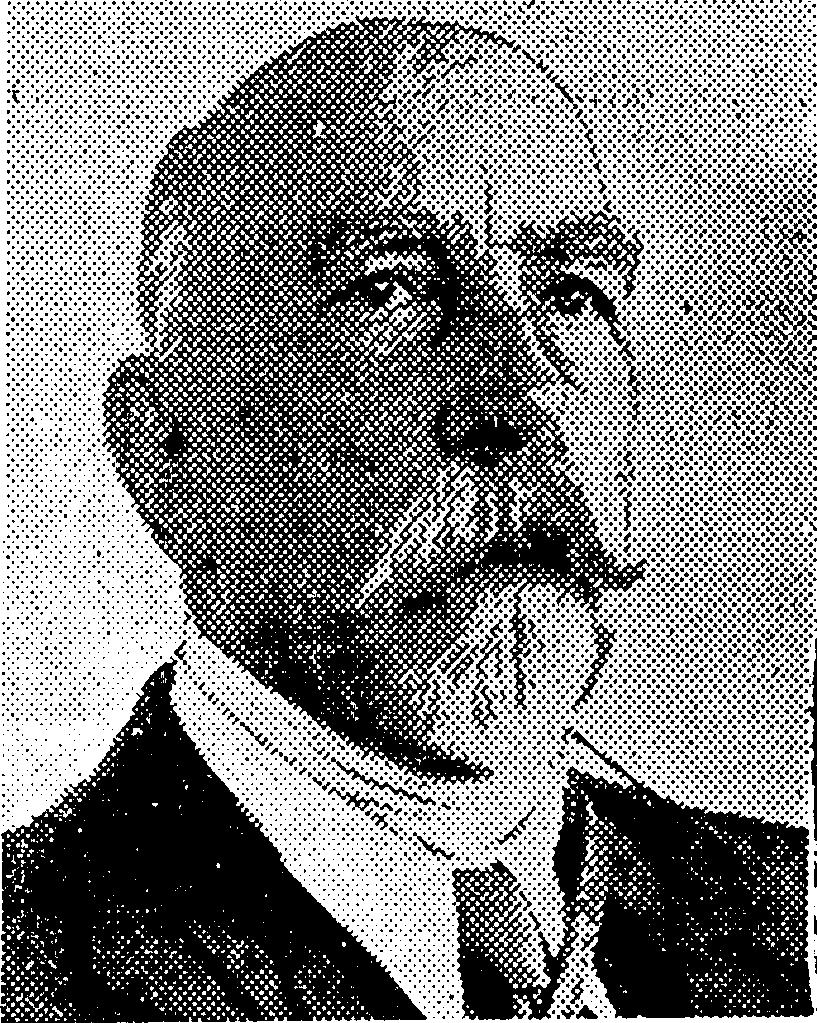
MR. ARTHUR VOGAN, a well-known archaeologist, a passenger on the Niagara.
NORTHERN ADVOCATE, 17 MAY 1934 - New Zealand newspaper.
LAST week Mr. A. J. Vogan gave a farewell luncheon in honor of Rev. W. Whonson bon-Aston, formerly Acting-Bishop in Fiji, and a great friend of Bishop Burgmann, who is now off to join Bishop Newton's staff in Papua. His guests included Mr. M. M. Murray (who was a well-known engineer in Hong-kong) and Mrs. Murray, and Mrs. Messmer, of orchid fame. Mr. Vogan had the day before given a packet to one of his guests, who had later in the same day been robbed of her handbag, including his present, on the Post Office steps.
The thief discarded the packet, which included a photograph of Mr. Vogan. The packet was returned to the photographer, who passed it on to Mr. Vogan. So at the luncheon, when his guest was telling him of her loss, he was able to hand it over to her once more. Intimate Jottings (1934, July 7). The Australian Women's Weekly (1933 - 1982), p. 23. Retrieved from http://nla.gov.au/nla.news-article47479004
AMAZING EXPLOITS OF ANCIENT ARCHAEOLOGIST
HE FOUND PERSIANS AT WOY WOY
IN the seclusion of the "Select Home for Aged Gentlemen," Pacific Lodge, Dee Why (Sydney), we found Arthur James Vogan, 88-year-old explorer, archaeologist and adventurer, who, in company with some other notables, once merited a mention in H. G. Wells' "Outline of History."
SAID Wells: "There are also, says Mr. Vogan, Chinese rock carvings in New Zealand and New California." (Page 581, "Intellectual Fetters of China" section).
"Stuff," Mr. Vogan told us.
Ancient Persians are practically Mr. Vogan's pet subject.
He is a giant in stature, and still as straight as a ramrod in spite of years, snake-bites, and the heavy pair of binoculars he carries round his neck in case something interesting chances up in the distance. A snowy pair of moustaches and a goatee beard give him an air of scientific distinction, enhanced by a magnifying glass which is a companion piece to the binoculars.
"I said New Caledonia, not New California."
He has amended his own copy of the work, with a neat marginal note. He has not, however, seen fit to advise H. G. Wells of the correction. For, as we soon discovered, the honor of being a quotable authority is one of the least exciting things in Mr. Vogan's life story. At random, he told us that he had been bitten so often by snakes on exploring expeditions that he had lost all fear of them. "Australian snakes are more or less harmless." he said.
"Fear kills more people than poison."
He gave us an illustration:— Before the Boer War, he was in NW Queensland representing the "Illustrated London News." He joined a party going out to investigate a report that a drover was dying from snake bite in a lonely hut. The man was dead when they arrived, but had left a curt note saying, "Bitten by snake. Am dying."
It was found, says Mr. Vogan, that the drover had left his hut at the dead of night for a private purpose. His heel had rested on a piece of barbed wire which sprang up and smacked him behind. Fear had done the rest. Then, it was at Woy Woy, some 40 miles from Sydney, that he found a rock on which were carved nine hares which could only have been the work of ancient Persians or Arabs. Ancient Persians are practically Mr. Vogan's pet subject.. '
"The hare is sacred to them, you know."
While exploring round the Fijian Group, Vogan found what he claimed to be evidence of Persian occupation 2000 years before. His main discovery was a 40ft. statue carved into a cliff face of a man sitting with a child on his knee. The man wore ancient Persian snow boots and the child a peaked Persian straw hat. He has also developed a theory that the Maoris came from India, being sent to NZ by the grandson of one Chandra Dunta.
"Is "Is your theory generally accepted?” we asked
"Ha! It has never been denied."
Delving back further into his past, we discovered that about 1875 he had been present in Penn's Ironfoundry in England when Edward VII then Prince of Wales, had plunged his hand into molten metal. The Prince was making a tour of inspection. Vogan, whose father was a friend of Penn's, had wangled his way into the official party.
A foreman performed the act as a novelty, and the Prince insisted on following him despite patriotic protests from all present. "They wiped his hand with a silk handkerchief. Hi calmly dipped his hand into the pot and suffered no harm. There was nothing to it."
After two years medicine at Barts, in London, Vogan decided to go to NZ and breed horses. He arrived there in 1880. Before he could do much breeding he fell desperately in love. The lady proved so unkind that he determined on some desperately risky mission which would result in his death. Then he met Sir Julius Vogel, Prime' Minister of NZ. Sir Julius was looking for a likely young man to represent the country in an expedition which the Royal Geographical Society of Australasia was planning to send to New Guinea.
Vogan got the job and went to Australia. To fill in time, he began the first St. John's Ambulance class in Australia, at Petersham, Sydney. He had been an original member of the organisation in England. Finally the party got away to New Guinea. Vogan fulfilling the functions of assistant surgeon, artist, and chief of the whale boat. "Natives attacked us 22 times.”
"Were you injured?"
"Well, going up the Fly River 800 of the beggars began firing arrows at us. I decided to walk along the deck, and do you know I could not move my left foot, I looked down and found it had been transfixed with an arrow."
We peered at Mr. V's left boot. "i heal very quickly," he said. "The mark has quite gone. But I have a suitable mark on my right foot, and if necessary I transfer the tale over."
After this, it seems almost humdrum to record that Vogan won the Royal Humane Society's medal for saving a boy from Sydney University pond, led a group of scouts in the Boer War and acted as Australian authority for the 1899 edition of Webster's Dictionary.
AMAZING EXPLOITS OF ANCIENT ARCHAEOLOGIST (1946, August 10).Smith's Weekly (Sydney, NSW : 1919 - 1950), p. 28. Retrieved from http://nla.gov.au/nla.news-article240009037
This is the series of carvings Mr. Vogan had seen at Kariong which he thought were rabbits - even though it is more likely they were bilbys (since extinct in that area)or even bandicoots - or perhaps he could have asked local descendants who may have been able to disspell his theories (more modern interpretations state these are possible men in ritual head-dress).
'Sermons in Stones'
(By Arthur J. Vogan, F.R.G.S., &c.)
'Examples draw when precept fails, And sermons are less read than tales.' — Prior's 'The Turtle and the Sparrow. '
The real interest which intelligent visitors to Woy Woy take in the so-called 'aboriginal carvings' is probably in the mystery that attaches to their meaning. Whether their author-ship be that of the aboriginals, as generally supposed, or is to be found in old-time, ' ' temeraire ' ' voyagers along their coast from Asia, is still a vexed question. Let us consider for a while some of their characteristics, and see if we can gather anything interesting; something more than mere sightseeing affords to the modern, hungrily inquiring mind.
When I represented a London paper here, in the "carefree eighties,"' I often had lunch with the famous Detective Elliott, late of Scotland Yard, and he taught me many things that have been invaluable to me since. One of these was that when looking for a successful criminal remember what is his method of operation. For the prosperous thief, like the big business man, has generally a 'one-track' mind; and does his work in one fashion. Therefore, when we seek for the authors of our carvings, we should ask ourselves: 'Do our aborigines commonly make groovings in rocks'' Are they fond of the strenuous work of boring millions of shallow holes in sandstone; and joining these into lines and curves by chipping and rubbing?"
There are about three thousand groups of these cryptoglyphs; with a mileage of line of about a hundred miles. After I had examined these groovings about thirty years ago, I had correspondence about them with the famous English antiquarians, J. W. Perry and Elliot Smith; and finally Manchester University asked me to investigate the carvings of New Caledonia. Since then I have visited over eighty Pacific Islands; and have found stone-carvings on most of them. I think, therefore, from the evidence before us, we may safely start out on our search with the general idea that the same folk (or their cousins) who are guilty of one set of carvings, were the makers of all. In Australia we have similar carvings to those of our Cumberland county at Port Headland, in Westralia; and on the Flinders River and elsewhere in Queensland - all places accessible to sea-farers.
Of course, we have some isolated examples inland, on the Blue Mountains, &c.; but because an eccentric bird builds in an old boot, or in a sugar-basin in our house, the naturalist does not place it out of its particular species. The gulls that one sees breeding on Lake Pun Run in Peru, which is 14,000 feet above sea-level, are still gulls. The miserable scratchings and figures one finds in the Flinders Ranges, South Australia, are not comparable to ours; and their incidence is beyond our present inquiry. An experienced voyager through our Western Pacific island-groups soon gets to recognise that it is a habit (almost a mania) with certain native-peoples, to mark trees; and since educational advantages have reached "the poor, black, benighted heathen," the letters of the alphabet appear everywhere upon unoffending tree-trunks.
Our own race delights to pencil its insignificant initials upon the ancient walls of cathedrals and palaces which Cook's tourists infest in modern times; and every explorer builds his cairn upon the achieved "Peak of his Desire." So we should not wonder that wanderers from Asia, who we now know established a kind of civilisation in certain islands, should indulge in leaving evidences of their sojourn; or that they showed their gratitude to their gods for a safe voyage by painfully grooving our sandstones with representations of their divinities, together with signs indicating the whence of the wandering artist. In a brief article one cannot indulge in much detail, but let us compare the groups of figures near Woy Woy with evidence from elsewhere. There will be many who can recall that instance of heroism in 1923, when the whole British Empire waited on tip-toe for news of Mrs. Lilian A. Starr, of Peshawar Hospital, who had ventured into the wilds of Tirah to rescue Miss Mollie Ellis, who had been carried off by Afridi brigands. Her book, 'Tales of Tirah,' is one that all British youth should read. But besides its simple story of a tremendous feat accomplished amidst appalling dangers, it gives what scientific works by learned scientists have so far failed to reveal to us; the ordinary methods of the "common, or garden variety" of lowly Lamaist folk of Lesser Tibet — the accent, by the way, should be on the first syllable. Lamaism is not quite the same as Buddhism. It is more primitive; and its teaching is to the effect that life is a wheel that devolves in six stages, or circles.
The Darwin and Russel theory predicted that the SOUL goes through a kind of evolution — rising a step at each successful and preparative stage to another life-circle, towards that Nirvana, or absorption into the whole mass of things. That nothing walks with aimless feet; That not one life shall be destroyed, Or cast as rubbish to the void When God hath made the pile complete.
Now these circles of life are depicted in Buddhist temples as: —
(1) The beasts, or animals; (2) the yadaks, or demi-beast-men; (3) men; (4) demons (not the same as 'devils' with us); (5) demi-gods; (6) gods.
Now if you again consult the Woy Woy carvings you will soon recognise a similarity in the group-carvings to this idea. The wheel is not uncom mon; and the cross, or four winds (four quarters of the earth) is often met with. The wheel stands for meditation and for continuity. These six states continually revolve according to our behaviour in each existence. The famous Dorji, - or prayer-wheel, does not appear; but we have evidently a primitive form of what developed in Asia into Buddhism (the religion of Bodhi: Enlightenment) whose found-er, Sakymuni, was Buddha, the Awake. There are few peoples who have not evolved some theory of a divine maker who fashioned the world and the first man; Osiris, in Egypt; Marduk, in Mesopotamia; Prometheus, who stole the divine fire; and Maui, of the Poly-nesians — connecting, by the way, with the Maori of our time, and the 'Great and Holy Mauru, ' ruler of Eden of the Burmah peoples. Even the Austra-lian aboriginal refers to an Alcheringa — some vague, beatific time of the past, whence originated his beliefs and cus-toms, and the classic poets of Greece and Rome looked back upon a Golden Age.
My discovery of an immensely ancient Chinese inscription in mid-Pacific three years ago (which certain authorities, including our own Prof. Sadler, say is about 2000 years old), and many other evidences show us that the wind-swept 'dark purple sea' that stretches, with its myriad islands away northwards to Asia, the birthplace of man, has been travelled by adventurous folk for thousands of years. That great authority Kenneth Saunders informs us that Buddhism has been a missionary religion, sending out its missionaries to different unenlightened lands.
The great H. D. Daunt has shown us recently, also, that Biblical history refers really to matters that took place in Assam and around the Bay of Bengal; and that the Mesopotamian names were derived from the old homelands, as many of our own here have been.
We learn that the CROSS symbol originally arose with a symbol, like that upon our Woy Woy sandstone, denoting four-quarters of the world — used in India by an invading race that entered Mesopotamia thousands of years B.C. Dear old Berossus, writing four or three centuries before our era, describes a race of monsters, half-men, half fish (chain armour?) who entered from the Persian Gulf, and settling in Sumer (Me-sop.), introduced the arts of writing, agriculture, and working in metal. All the latest authorities, Marett, Fallanee, Fleure, Casson, and others, endorse this idea: That all the arts of Greece, of Egypt and Mesopotamia come to Asia Minor and Europe from Mother India; and the discoveries of very ancient skulls (of the round, not the primitive long shape) in New Caledonia by the author, and in New Zealand by Prof. Speight, and numerous other evidences indicate that the whole Pacific was navigated in pre-historic days. Look at the remains of the vast forts in the Yasawa, and other Fiji groups, and in New Zealand; at the triptych of great blocks of stone, or coral, here and there; at the thousands of carved stones, showing well-known sun-worshipping symbolisms, and the stone-foundationed old-time cities in certain islands; and we must recognise the fact that Australia, except in a financial sense, was never a lone (loan) land; and that Captain Cook and the Spaniards had many predecessors — long, long before. All these various types of stone symbolisms, cryptogryphs, and carv-ings in the islands are evidences of Asian voyagers; and why they passed into oblivion is a matter that must be left for another time. The use of such inquiry is in the fact that what destroys one civilisation may destroy a succeeding one. From the lessons of the past we can reap a knowledge of how to weather the storm and stress which beat with growing force as man climbs upwards from the primitive, towards the complicated methods of existence.
"Sermons in Stones" (1933, November 9).The Gosford Times and Wyong District Advocate (NSW : 1906 - 1954), p. 10. Retrieved fromhttp://nla.gov.au/nla.news-article167856399
RECENT ARCHAEOLOGICAL DISCOVERIES IN THE WESTERN PACIFIC.
BY ARTHUR J. VOGAN, F.R.G.S.
MY object in submitting my photographs of certain characteristic inscriptions, ciselures, and carvings found by me in little-known islands of the Western Pacific to the scientific world through the far-flung pages of our Journal, is in the hope of receiving some information regarding their authorship—especially from French savants, for reasons shown later. Although an immense amount of anthropological work has been done in the Pacific, very little archaeological evidence has been garnered until quite recently.
I was first imbued with my enthusiasm in this direction by my father's great friend Sir John Lubbock (later Lord Avebury) the famous F.R.S. whose home stood amongst Druidical monoliths; and, later, by Mrs. Routledge, of Easter Island fame—who advised me to search Fiji “as nothing has been done there yet!” In my constant wanderings about Australasia on mining-business, I had multitudinous opportunities for observing the neglected archaeological features; and I determined to follow these up when the opportunity arrived. But what really determined me was the discovery that the so-called “Aboriginal Carvings” of the Sydney littoral were done by Asiatics—the first conclusive evidence of which were the “graffiti” in the Hawkesbury-sand-stone (Tenison-Woods) of Woywoy inner-harbour, clearly representing the well-known Hares (see fig. 1) of the Moon-series of India. As these pests were not introduced by sportsmen here until about 1837, and as the ciselures are clearly very ancient to anyone experienced regarding the effect of weather on stone, and as the hare takes the place of our man-in-the-moon in Asia, here was further corroboration of what I had noticed elsewhere. This led to my study of those rock-carvings around Sydney, numbering about 20,000, which Surveyor W. D. Campbell shows in his remarkable book—the result of many years hard and ill-requited labour. To anyone who has studied the subject, it- 100 is quite clear that they were done by Asiatics voyaging down the coast, as others voyaged past New Caledonia and the different land-radii projecting into the Pacific from the Malay Islands depayser. Sir George Grey's Journal (1834-39), a copy of which that historic statesman gave me in 1886, after my return from New Guinea, shows rock-carvings and cave-paintings he discovered along the West Australian coast (Glenely river); and at Port Headlands are “graffiti” like those of Sydney. But it was not until I came across that far-seeing work of Dr. Dunmore Lang: Origins and Migrations of the Polynesian Nation (1834) that I finally determined to devote myself to gathering further evidence. When exploring in what is now Papua in 1885, I was astonished to find how closely the Malay crew resembled my Maori friends. Their handling the oars and sails, and many of their habits were the same; and their string-tricks (cats-cradles), games, and many words were identical.
In H. D. Daunt's Center of Civilisation was disclosed the clue to the “Whence of the Maori Race”—to use the title of the book of that painstaking New Zealand author, S. Percy Smith, founder of our Society. After another wandering visit to Papua, I spent a year in New Caledonia where I found what Prof. Rhys calls “Ogmaic” inscriptions, spirals like those of India, New Grange (Scotland) Mycenae, and other widely separated places; and hundreds of “Sun-stones” (almanacs or dials) (see fig. 6) like those of Dogura and elsewhere among the north-east littoral of Papua—again showing the route taken by the early Asiatic adventurers.
The longer one studies any branch of science, the more one is impressed with the immensity and infinity of the field ahead. But the casual observer (“That curse of science!” as the great J. Jenner Weir termed him) is cheerfully ready to become the victim of ready-made explanations, theories, and dogmatism. I have often asked white-folk as well as natives if what I was searching for obtained in their vicinity—to receive an answer in the negative, even when my misinformant was standing in the midst of much valuable and conspicuous occulis subjecta fidelibus. After visiting Australia, New Zealand, Papua, and New Caledonia, following the advice from Mrs. Routledge I spent the best part of five years in and around the Fiji group. There I had the- 101 good fortune to meet that well-known trader, Captain Giblin, of the Yasawa islands, which lie off the western coast of Viti Levu. Here I found several temple-caves containing about 150 ancient inscriptions (or perhaps ‘signatures’ recording visits) of which fig. 3 shows a characteristic group, casts of which are now in the Cambridge University, the Auckland, and other museums; also the carved head of a man with monkey-jaw, which may be the monkey-god of India. Having submitted my photos, to probably the best authority in Australasia, Dr. C. A. Monticone, the New South Wales Government hermeneutics expert, who has encouraged my Pacific work for many years, that gentleman permits me to state that these ciselures are evidently very ancient, and show such an admixture of Indian and Chinese characters that they were probably cut by visitors from Indo-Chine.
Friends who have visited the famous caves of the bay of Along, Tongking, further corroborate this, as also does Franck's book East of Siam which illustrates cave-inscriptions. A year or two later, I discovered another old settlement of Asiatics which I have called “The Sanctuary.” This is situated on the southern coast of what may be called the lower-jaw of Vanua Levu (Long-land), that northern half of Fiji that bears on the map a remarkable resemblance to a sword-fish. An exquisitely beautiful bay below Fawn hill being reached across the dangerous, reef and current-guarded Somosomo 1 strait, the visitor climbs upward about 300 feet, to where, upon a ridge, between a mountain-side and an impassable stream-cut gorge, lie about sixty great flat rocks (apparently augite-andesite and highly magnetic) bearing deeply cut symbols or letters (see fig. 7) of similar character to those of the Vanua cave-temples. These rocks evidently once walled off about sixty acres of rich alluvium, still used for yam-growing by the natives; and I was delighted to find in corroboration of this that the village in the valley beneath is still called Duku-ni-ba, which means “behind the fence.” Fig. 9 shows the script on a copper-vessel known to be over 1,500 years old from Pekin, which the late L. T. Griffin of the Auckland museum considered showed the same school of design to that of my Fijian finds.
- 102
In 1932 whilst my casts of the Yasawa-i-lau cave-temple carvings were drying I visited the north end of the main island. Here a low ridge of rocks occurs, on which an old native fort reminds one of the piratical days of the Hennings's gang, that only passed away a generation ago; and in 1789 Captain Bligh, after the Bounty mutiny, miraculously passed 14 miles northward of this point on his way to Java. Here I made my most important archaeological discovery; and if I say “of the Pacific, so far,” I probably shall not be wrong. As I turned the western sea-front of this rocky ridge I saw before me a gigantic and majestic figure-group of a man nursing a child (see fig. 5). I thought for a moment that I had received a touch of the sun, or was ill—could not believe my eyes! How is it that this has not been reported? Very few whites come this way of course, and these are solely concerned in trading or smuggling. Here we have a group about 45ft. high, consisting of a seated male figure, upon whose knee is a plump child that leans forward as if to kiss him. It is no weird, savage piece of sculpture like the Korean figures of Easter Island, it is a genuine work of ancient art by masters of their craft. Who were they? To anyone versed in the history of art of past Asiatic days the group bears upon it the convincing solution of the conundrum. For the man wears the famous snow-boots, and the child the typical pointed straw-cap of Persian statuary. On the weather-(western) side all trace of chisel-work and feature have long since disappeared; but on the land-side the chubby cheek and fat arm show the dimples; and the man's ear is intact.
The natural, solid rock has been used as far as the waistline of the figures, and the rest has been built-up with large blocks—the stone (a basic-andesite probably) forms part of that great submarine-plateau that, rising, formed the group. Nothing of course can be gathered from the natives about this or any other archaeological feature. Chiefly Tongans by descent, their arrival here was hundreds of years later than the carvings were made; and the Fijians were later still, showing by their language that they arrived from Tanganyika. By that, certain customs, and witchcraft methods, we shall probably be justified in placing them as
- i
FIG. 1.
- ii
FIG. 2.
FIG. 3.
- iii
FIG. 4.
- iv
FIG. 5.
- v
FIG. 6.
FIG. 7.
- vi
FIG. 8.
FIG. 9.
- 103
the descendants of those African crews of large Arab trading vessels (carrying up to 500 persons) that Daunt and Alfred K. Newman and others tell us about as passing through the Pacific over 1500 years ago.
ILLUSTRATIONS
Fig. 1—Seven-phases-of-the-moon ciselure upon Hawkesbury sand-stone: inner-harbour Woywoy near Sydney, N.S.W. Very ancient, and facing east. Were probably made by Asiatic voyagers some hundreds of years since. Hares were only introduced about 1837. The hare was sacred to the ancient Britons (Caesar: De Bello Gallico Bk. 5) and Aphrodite.
Fig 2.—Water-entrance to temple-cave (no. 1) Yasawa-i-lau island opposite northeast coast of Viti Levu. Showing swastika of Indian type where sun falls on spot afternoon; and the graffiti of presumed Indian origin over secret entrance (by diving) to inner, unlighted (save by small hole in roof) cave. Water over floor of cave averaging thirty feet in depth. Casts of carving shown on fig. 3. Rock is what used to be called coral-limestone, but which Maurice Black has shown to be limestone precipated by bacteria—as at Bahama, etc. The bed of ocean has been lifted from horizontal to perpendicular position. Adjoining igneous rocks augite-andesites apparently. There is a Budhist holy-water font and “Seven-steps” in land-entrance, with about fifty graffiti, or “Signatures” of penitents or visitors.
Fig. 3—Photo of rubbings of casts (taken by the author) now in Cambridge University, Auckland, and other museums, of typical graffiti in said temple-cave. The largest example is that over secret-entrance to inner cave.
Fig. 4—When taking cast of carving over secret entrance on bridge I had built across water (see fig. 2) I saw what appeared to be a natural pulpit standing up out of water. It cannot be seen from the “Temple” or land-entrance proper. On it appeared this head, about eight feet from chin to crown. It reminds one of the monkey-god of India. I was artist for Illus. London News for two years and over, and this is a carefully-drawn representation of the head, which I could not successfully photograph owing to want of light and absence of illuminants.
Fig. 5—Figure-group, about 45 feet high. It consist of a bare-headed man sitting with child on knee as described in text. I owe my discovery of this to the famous Gilbert Island and Fiji trader, Captain Giblin, who told me of a great statute but did not intimate its position on the islands.
Fig. 6—“Sun-Stones” at Dogura, north-east coast of Papua, which are exactly like those of the western-coast of New Caledonia,- 104 where I found the “Ogmaic” inscription in 1929. Milne Bay shows a still finer example of “sun-dial,” or, rather “season-dial,” with marks showing where the gnomon once stood.
Fig. 7—Rocks at Duku-ni-ba, Vanua-levu, covered with inscriptions, or what are possibly the “sign-manuals” of penitents or worshippers, as in case of Yasawa caves, etc.
Fig. 8—Rubbings of a number of the characters mentioned above (fig. 7). I have to thank a local planter named Arthur Robinson for assisting me in this, the second most valuable archaeological find made in Fiji.
Fig. 9—Inscriptions upon a copper vessel known to be over 1,500 years old that came from Pekin, and is now in Auckland Museum, New Zealand. The similarity of the letter-words to many of those found carved upon the rocks of Fiji does not require emphasizing.
1 Somo Somo on the map, and so written by author.
Vogan, A.J. ‘Recent archaeological discoveries in the Western Pacific’, Journal of the Polynesian Society, vol. 46 [2], pp. 99-104. 1937
 | THE CATASTROPHE IN NEW GUINEA 1885 false report on their demise.pdf Size : 92.571 Kb Type : pdf |
Photographers of Pittwater and her Environs: A. J. (Arthur James) Vogan, 1859-1948 Historical - A J Guesdon, 2018